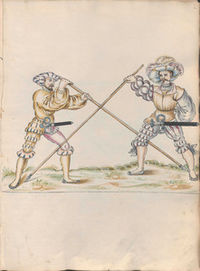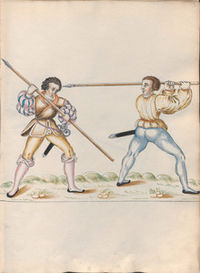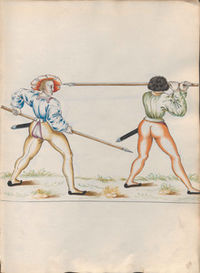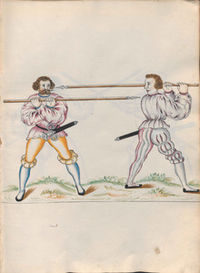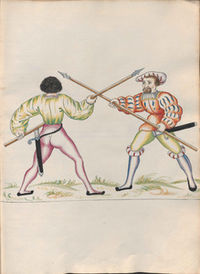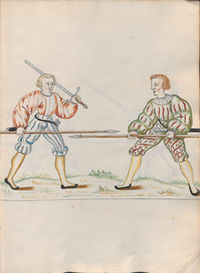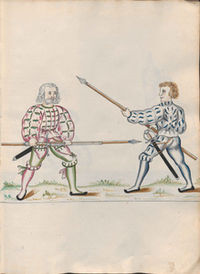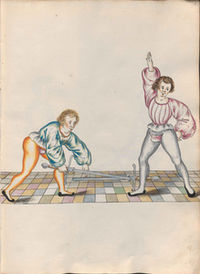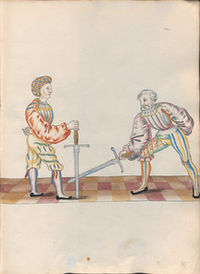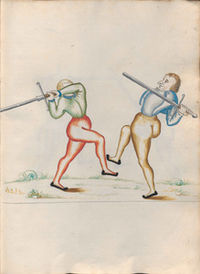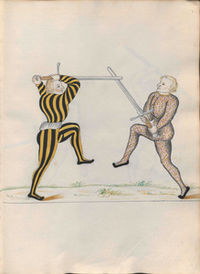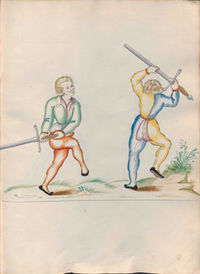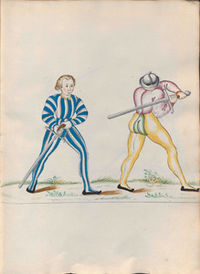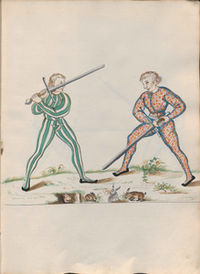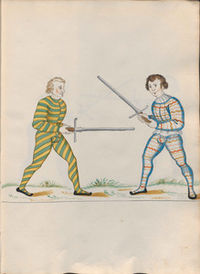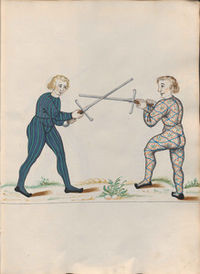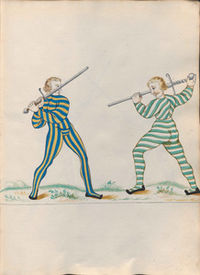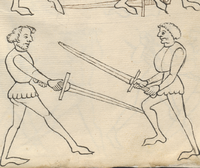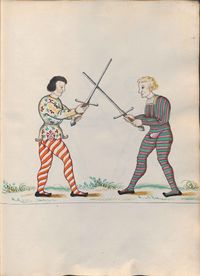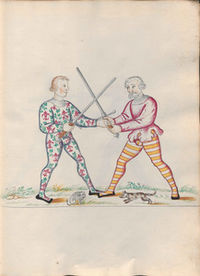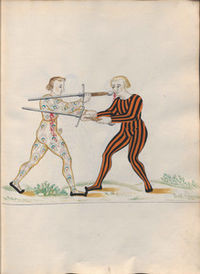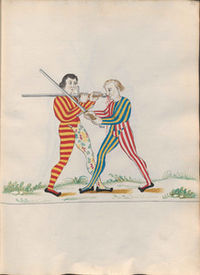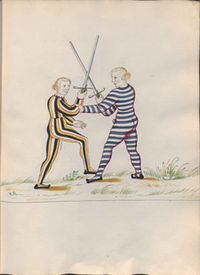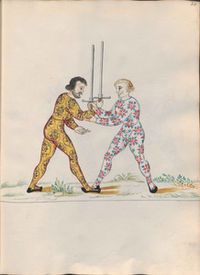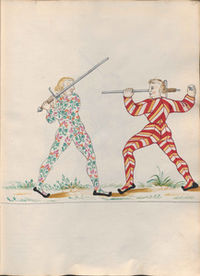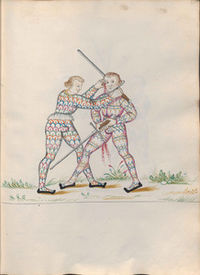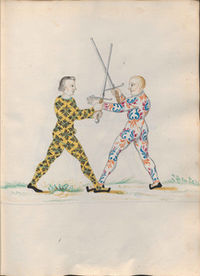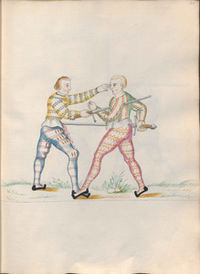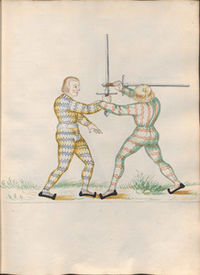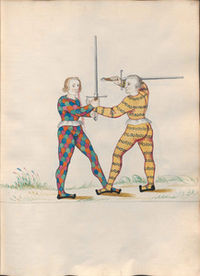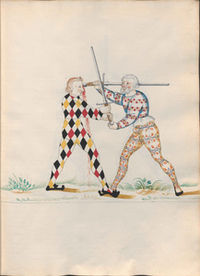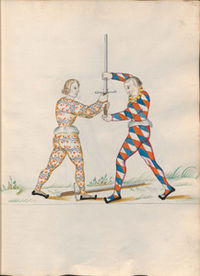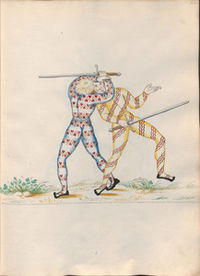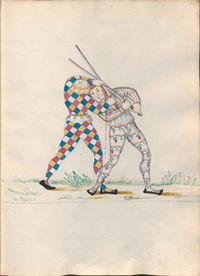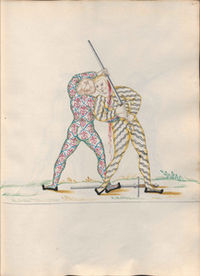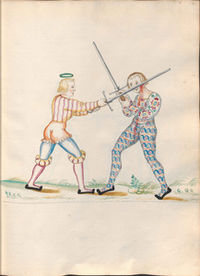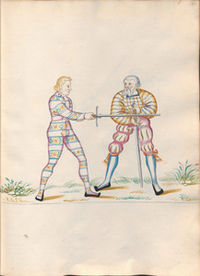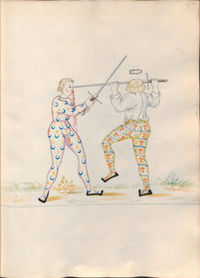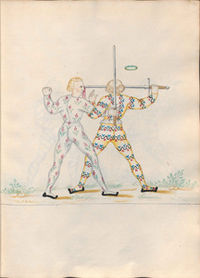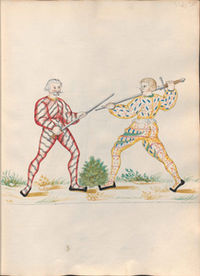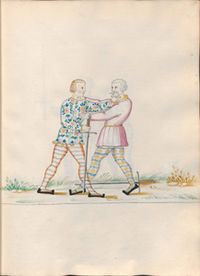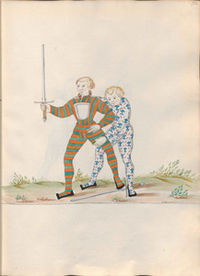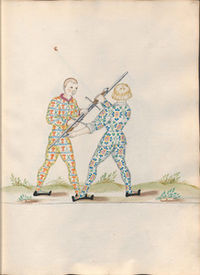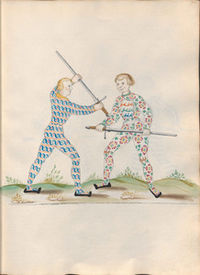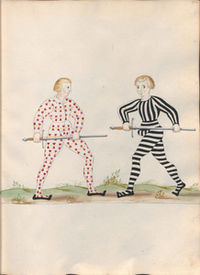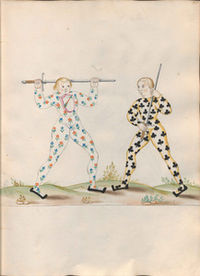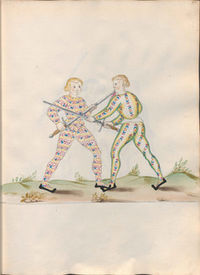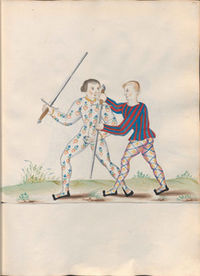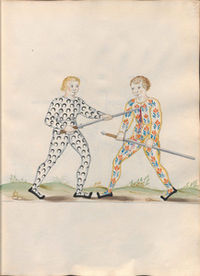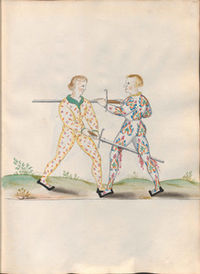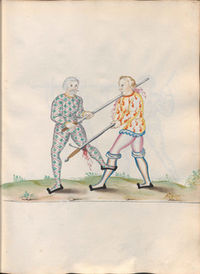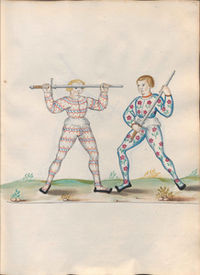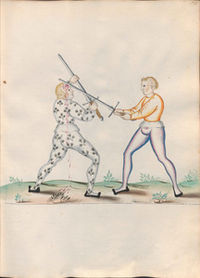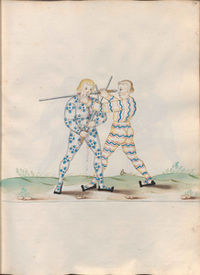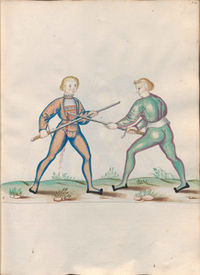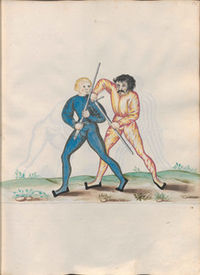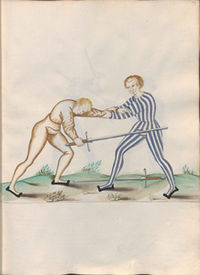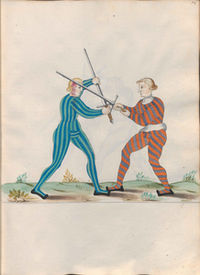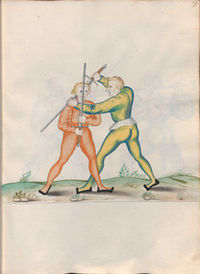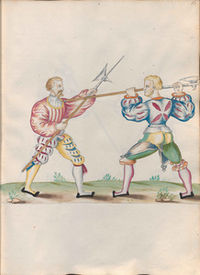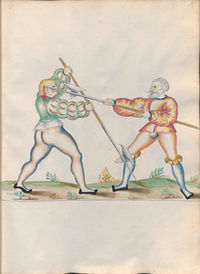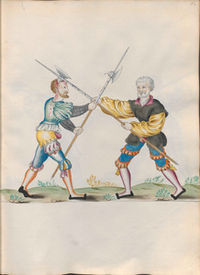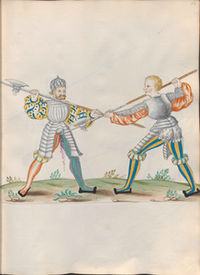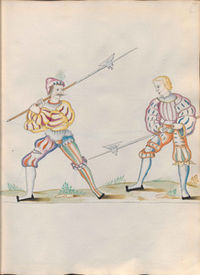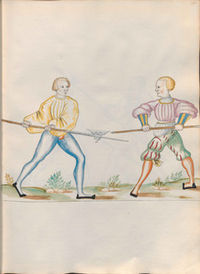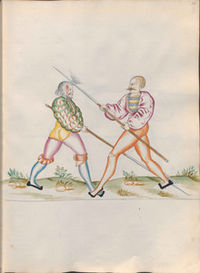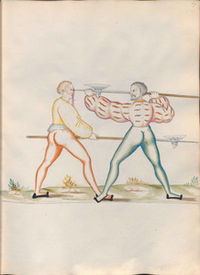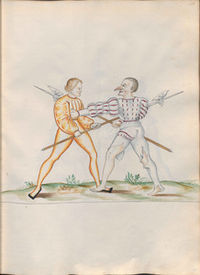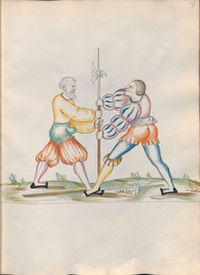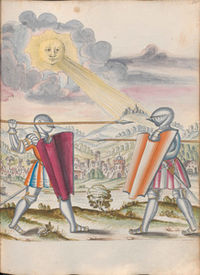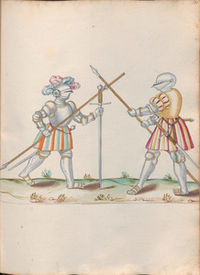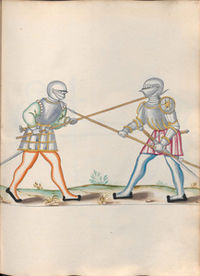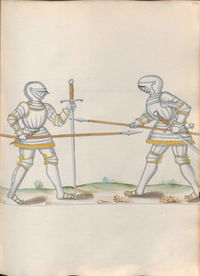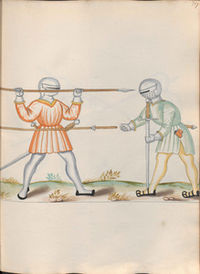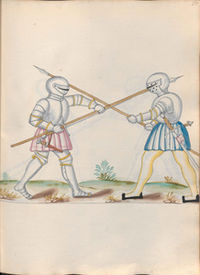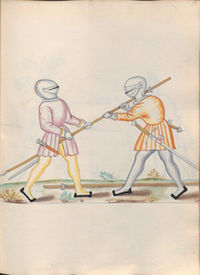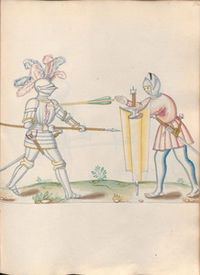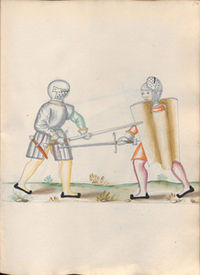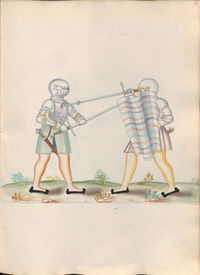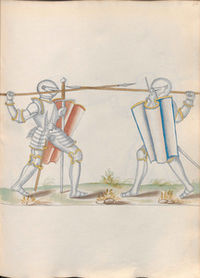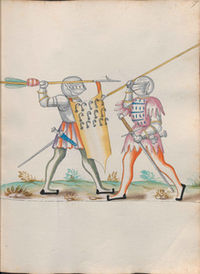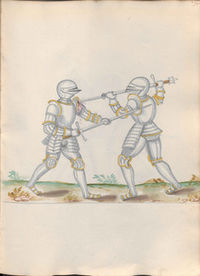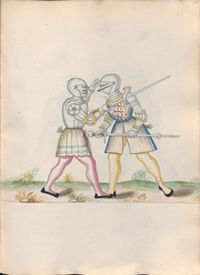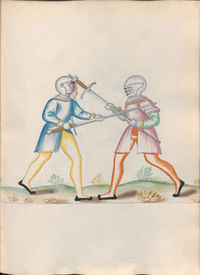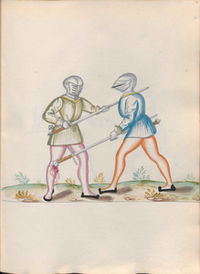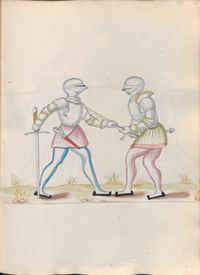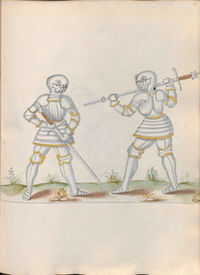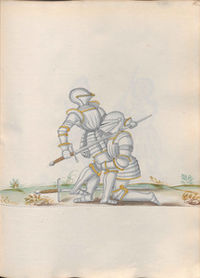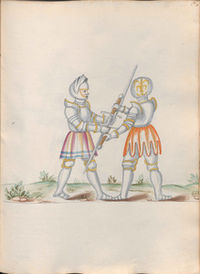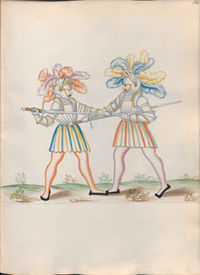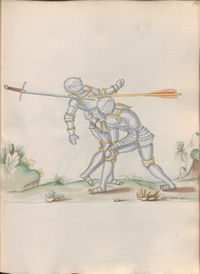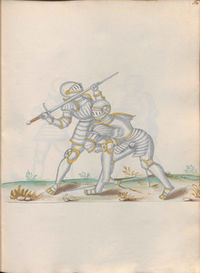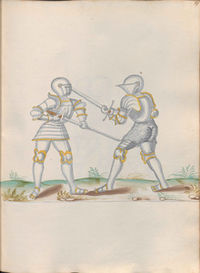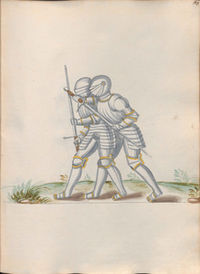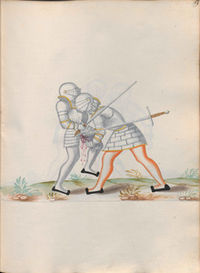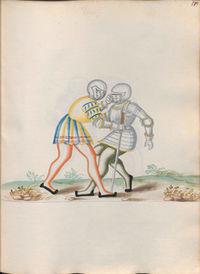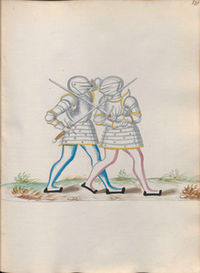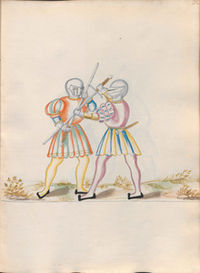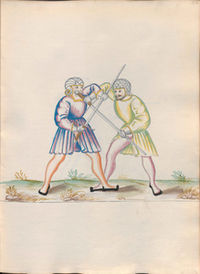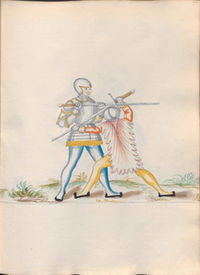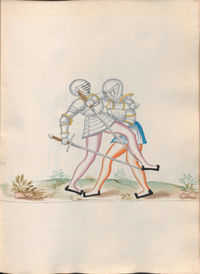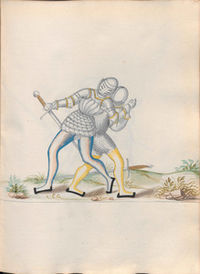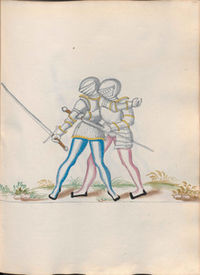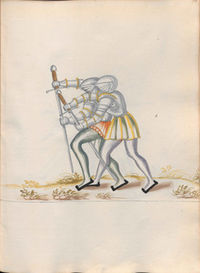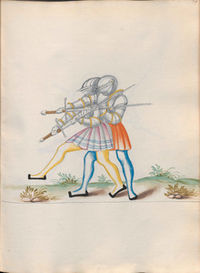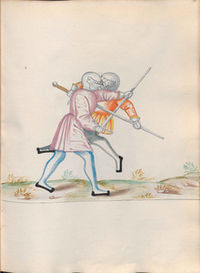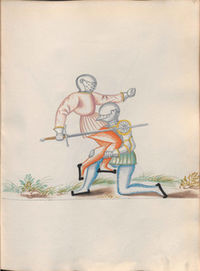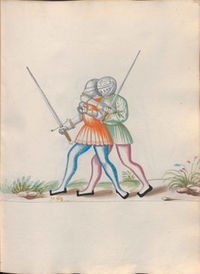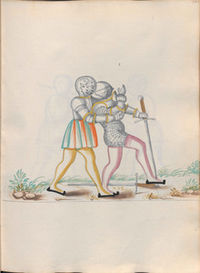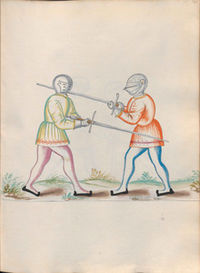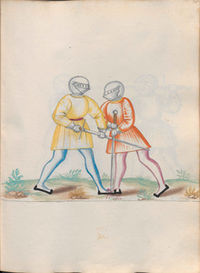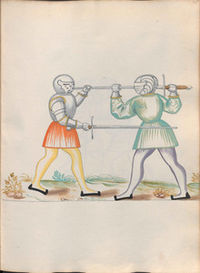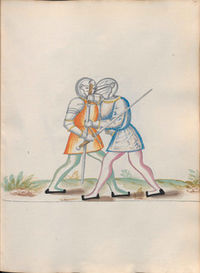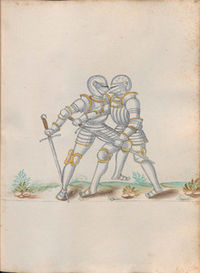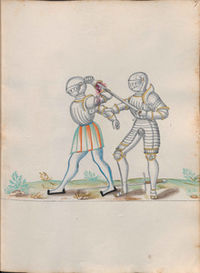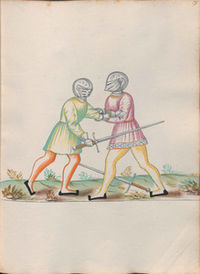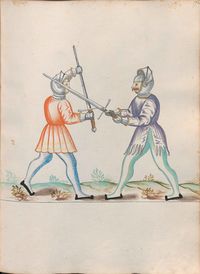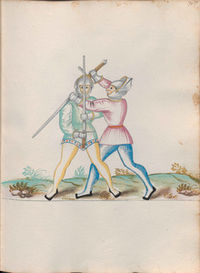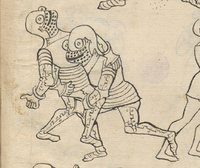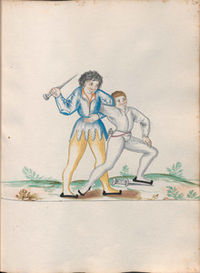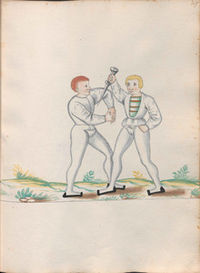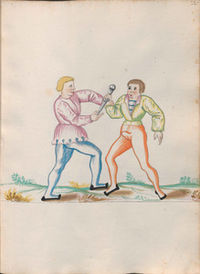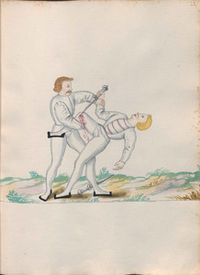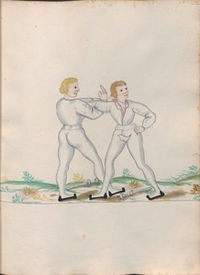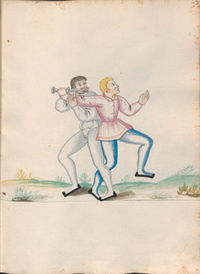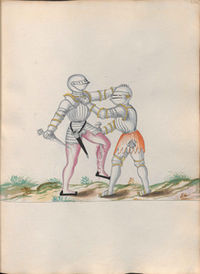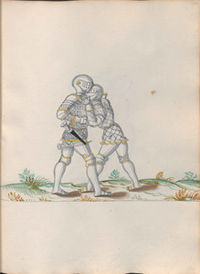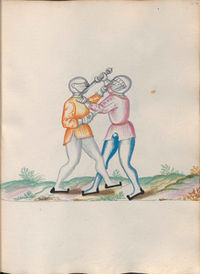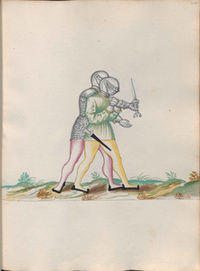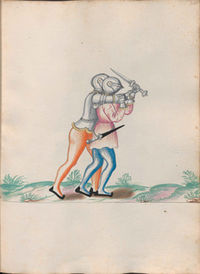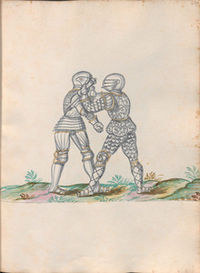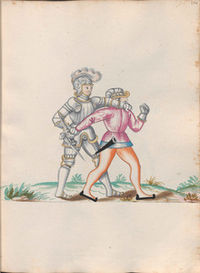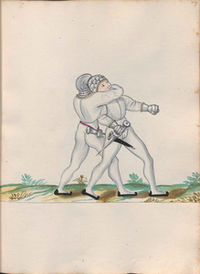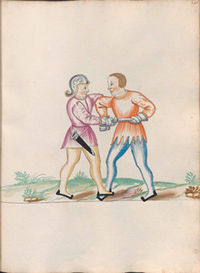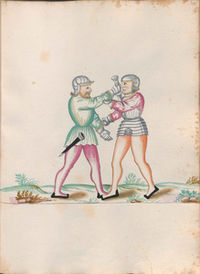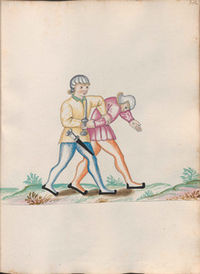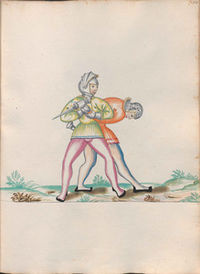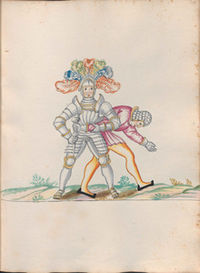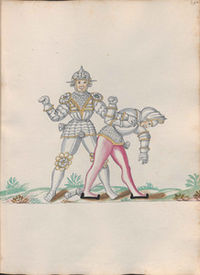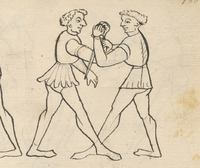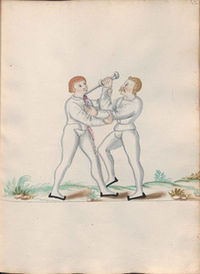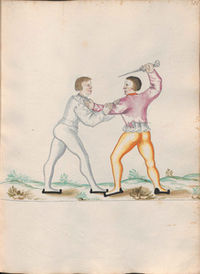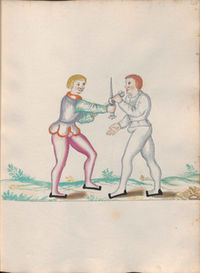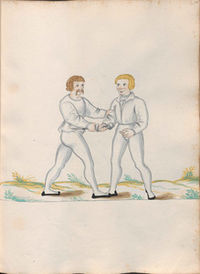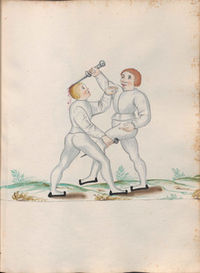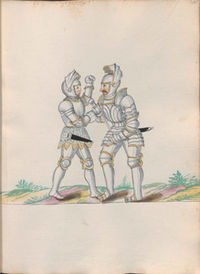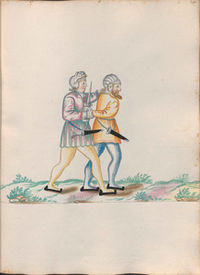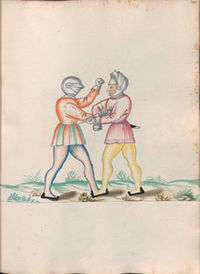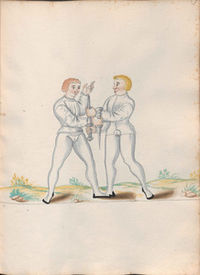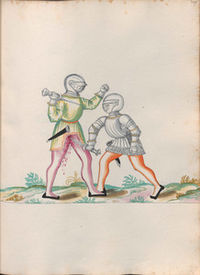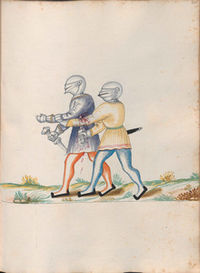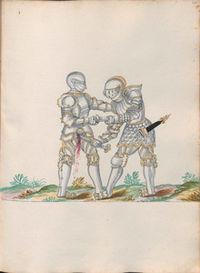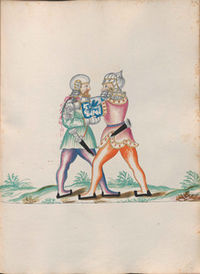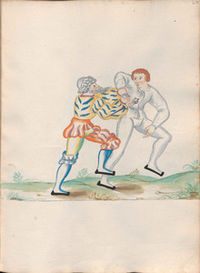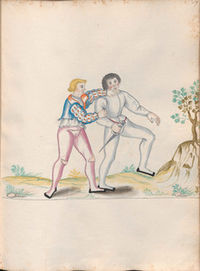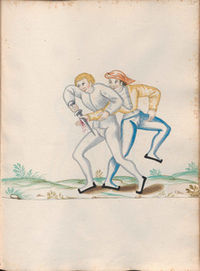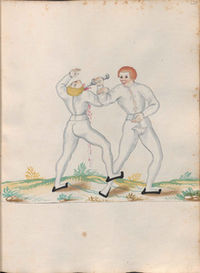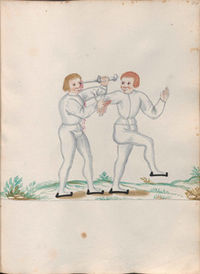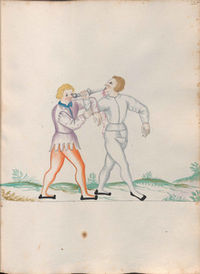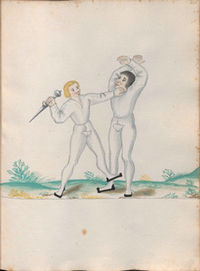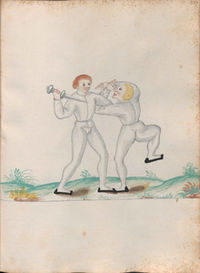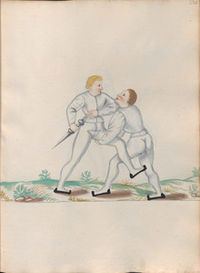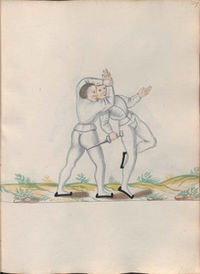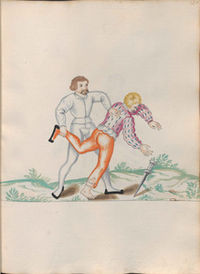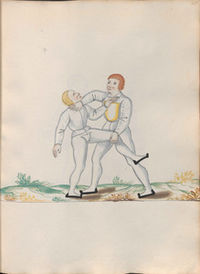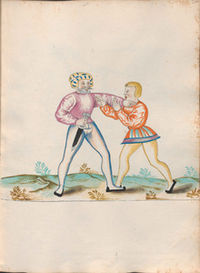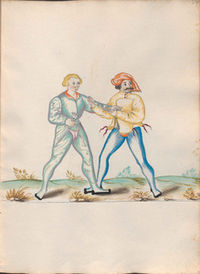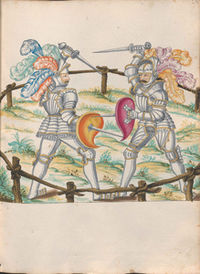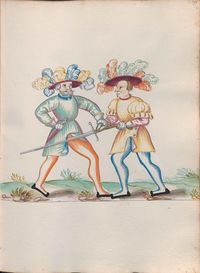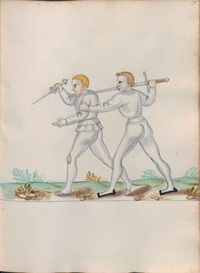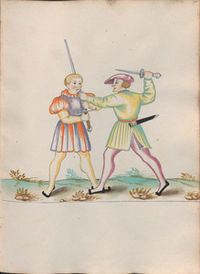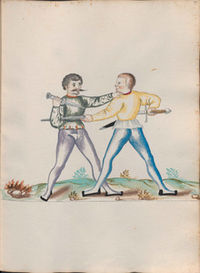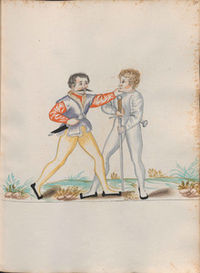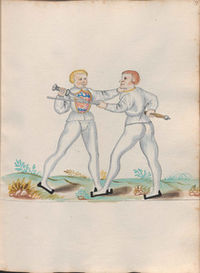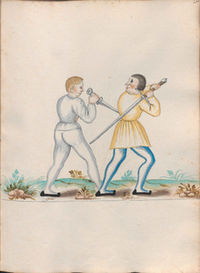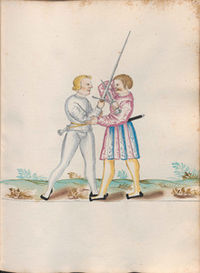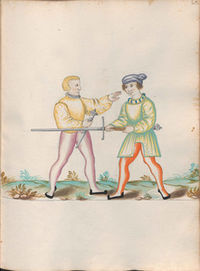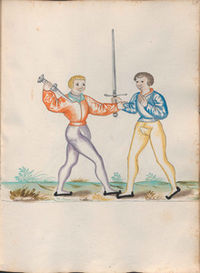|
|
You are not currently logged in. Are you accessing the unsecure (http) portal? Click here to switch to the secure portal. |
Die Blume des Kampfes
| “Die Blume des Kampfes” | |
|---|---|
| The Flower of Battle | |
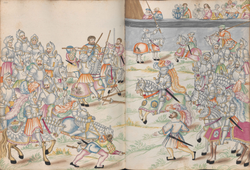
| |
| Author(s) |
|
| Ascribed to |
|
| Illustrated by | Unknown |
| Date | before 1420s |
| Genre | |
| Language | Early New High German |
| State of Existence | Original hypothetical; multiple incomplete copies exist |
| Manuscript(s) |
|
| Concordance by | Michael Chidester |
Die Blume des Kampfes (“The Flower of Battle”) is a nickname given to a group of three German manuscripts that share a common technical syllabus and set of illustrations. It might be based on the tradition of 14th century Italian master Fiore de'i Liberi, from whose treatise Fior di Battaglia it derives its nickname, given that his works include considerable technical overlap. It is equally likely, though, that they represent an earlier German tradition of which Fiore was himself an initiate. Fiore mentions in his prefaces that he owned books on the art and he also names two older masters in his tradition, Johane Suveno and Nicholai de Toblem; it is possible that either or both of those masters authored texts which inspired both this tradition as well as Fiore's own writings.
The oldest manuscript in the Blume des Kampfes group is the Cod. 5278, which dates to the late 1420s and contains only crude line drawings somewhat reminiscent of the art of Fiore de'i Liberi, though lacking many signature characteristics such as garters and crowns and generally less organized than the Friulian master's work. The second entry was completed in ca. 1500 by Ludwig VI von Eyb, and contains a significant degree of overlap with the 5278 but also a wealth of new material. While the artwork, though colored, is of similar quality, Eyb's treatise improves on its predecessor by including detailed German descriptions of the devices in most of its sections. Whether this text was authored by Eyb or present in the sources upon which he based his work cannot currently be determined.
The final manuscript, Cod. 10799, is dated 1623 and is again textless. Unlike its fellows, though, it is illustrated with watercolors of high quality; it is also the most extensive of the three by far, encompassing nearly every device from both works as well as a number of unique devices that suggest that it was either not derived directly from the other two known manuscripts or that it used additional sources currently lost to us. The two older manuscripts include war books derived from Konrad Kyeser's famous treatise on siege warfare Bellifortis, and the copyist of the 10799 also included the few Bellifortis illustrations that seem to portray knights and soldiers, perhaps indicating that he did not understand what he was copying. Aside from the Blume des Kampfes material, the 10799 also has a good deal of extra material, including portrayals of laying down and taking up the sword, Germanic sash wrestling, armored dagger and buckler, and the sword dance.
There is a fourth Germanic manuscript potentially connected to this tradition, the Cod.Guelf.78.2 Aug.2º. This manuscript, dating to between 1465 and 1480, includes a version of Johannes Liechtenauer's record, a complete set of illustrations from Gladiatoria, and a heavily-abridged version of Bellifortis. Tucked away amidst these works are illustrations of fencing with sword, spear, axe, and dagger that parallel the teachings of the Blume des Kampfes but only occasionally replicate them exactly. While this may simply be a case of an overambitious artist reinterpreting the manuscript art he was copying, the differences are too many to include the manuscript in the concordance below.
Contents
Treatise
Like Fior di Battaglia, die Blume des Kampfes treats grappling, dagger (including dagger against sword), sword both armored and unarmored, poleaxe/halberd, spear, and mounted fencing; it also includes unique content such as armored sword and shield and dueling with longshields. In comparison to its Italic counterpart, the Germanic works place a much greater emphasis on armored fencing, doubling or tripling the number of devices, and also dwarf Fiore's own rather brief treatment of unarmored grappling. The dagger, sword, and polearm material is all more or less consistent across both traditions, and where available the explanatory text, though unconnected to that of Fiore, demonstrates a similar understanding or interpretation of the techniques.
Images |
Erlangen Version (1500) [edit] |
Vienna Version I (1420s) (?) [edit] |
Vienna Version II (1623) [edit] | |
|---|---|---|---|---|
[1] [No text] |
[002r] [No text] | |||
[2] [No text] |
[177r-a] [No text] |
[003r] [No text] | ||
[3] [No text] |
[177r-c] [No text] |
[004r] [No text] | ||
[4] [No text] |
[177r-e] [No text] |
[005r] [No text] | ||
[5] [No text] |
[178r-a] [No text] |
[006r] [No text] | ||
[6] [No text] |
[182r-a] [No text] |
[007r] [No text] | ||
[7] [No text] |
[182r-c] [No text] |
[008r] [No text] |
Images |
Erlangen Version (1500) [edit] |
Vienna Version I (1420s) (?) [edit] |
Vienna Version II (1623) [edit] | |
|---|---|---|---|---|
[1] [No text] |
[009r] [No text] | |||
[2] [No text] |
[010r] [No text] | |||
[3] [No text] |
[51v-a] [No text] |
[011r] [No text] | ||
[4] [No text] |
[51v-b] [No text] |
[012r] [No text] | ||
[5] [No text] |
[51v-d] [No text] |
[013r] [No text] | ||
[6] [No text] |
[196r-e] [No text] |
[014r] [No text] | ||
[7] [No text] |
[197r-a] [No text] |
[015r] [No text] | ||
[8] [No text] |
[197r-c] [No text] |
[016r] [No text] | ||
[9] [No text] |
[197r-e] [No text] (Similar) |
[017r] [No text] | ||
[10] [No text] |
[018r] [No text] | |||
[11] [No text] |
[200r-e] [No text] |
|||
[12] [No text] |
[198r-a] [No text] |
[019r] [No text] | ||
[13] [No text] |
[198r-b] [No text] |
[020r] [No text] | ||
[14] [No text] |
[198r-c] [No text] |
[021r] [No text] | ||
[15] [No text] |
[198r-d] [No text] |
[022r] [No text] | ||
[16] [No text] |
[198r-e] [No text] |
[023r] [No text] | ||
[17] [No text] |
[198r-f] [No text] |
[024r] [No text] | ||
[18] [No text] |
[025r] [No text] | |||
[19] [No text] |
[199r-a] [No text] |
[026r] [No text] | ||
[20] [No text] |
[199r-b] [No text] |
[027r] [No text] | ||
[21] [No text] |
[199r-c] [No text] |
[028r] [No text] | ||
[22] [No text] |
[199r-d] [No text] |
[029r] [No text] | ||
[23] [No text] |
[199r-e] [No text] |
[030r] [No text] | ||
[24] [No text] |
[199r-f] [No text] |
[031r] [No text] | ||
[25] [No text] |
[200r-a] [No text] |
[032r] [No text] | ||
[26] [No text] |
[200r-b] [No text] |
[033r] [No text] | ||
[27] [No text] |
[200r-c] [No text] |
[034r] [No text] | ||
[28] [No text] |
[200r-d] [No text] |
[035r] [No text] | ||
[29] [No text] |
[16r-a] [No text] |
[201r-a] [No text] |
[036r] [No text] | |
[30] [No text] |
[16r-b] [No text] |
[201r-b] [No text] |
[037r] [No text] | |
[31] [No text] |
[16r-c] [No text] |
[201r-c] [No text] |
[038r] [No text] | |
[32] [No text] |
[16r-d] [No text] |
[201r-d] [No text] |
[039r] [No text] | |
[33] [No text] |
[182r-e] [No text] |
[040r] [No text] | ||
[34] [No text] |
[183r-a] [No text] |
[041r] [No text] | ||
[35] [No text] |
[183r-b] [No text] |
|||
[36] [No text] |
[183r-d] [No text] |
[042r] [No text] | ||
[37] [No text] |
[183r-e] [No text] |
[043r] [No text] | ||
[38] [No text] |
[185r-a] [No text] |
[044r] [No text] | ||
[39] [No text] |
[18r-c] [No text] |
[179r-e] [No text] [180r-a] [No text] |
[045r] [No text] | |
[40] [No text] |
[18r-e] [No text] |
[046r] [No text] | ||
[41] [No text] |
[18r-a] [No text] |
[047r] [No text] | ||
[42] [No text] |
[185r-d] [No text] |
[048r] [No text] | ||
[43] [No text] |
[185r-f] [No text] |
[049r] [No text] | ||
[44] [No text] |
[184r-f] [No text] |
[050r] [No text] | ||
[45] [No text] |
[051r] [No text] | |||
[46] [No text] |
[180r-c] [No text] (Repeat) |
[052r] [No text] | ||
[47] [No text] |
[180r-e] [No text] |
[053r] [No text] | ||
[48] [No text] |
[180r-f] [No text] |
[054r] [No text] | ||
[49] [No text] |
[181r-a] [No text] |
[055r] [No text] | ||
[50] [No text] |
[181r-b] [No text] |
[056r] [No text] | ||
[51] [No text] |
[25r-a] [No text] (Repeat) |
[057r] [No text] | ||
[52] [No text] |
[25r-c] [No text] (Repeat) |
[181r-e] [No text] (Repeat) |
[058r] [No text] | |
[53] [No text] |
[25r-d] [No text] (Repeat) |
[059r] [No text] |
Images |
Erlangen Version (1500) [edit] |
Vienna Version I (1420s) (?) [edit] |
Vienna Version II (1623) [edit] | |
|---|---|---|---|---|
[1] [No text] |
[177r-a] [No text] |
[060r] [No text] | ||
[2] [No text] |
[177r-b] [No text] |
[061r] [No text] | ||
[3] [No text] |
[177r-c] [No text] |
[062r] [No text] | ||
[4] [No text] |
[178r-a] [No text] |
[063r] [No text] | ||
[5] [No text] |
[178r-b] [No text] |
[064r] [No text] | ||
[6] [No text] |
[178r-c] [No text] |
[065r] [No text] | ||
[7] [No text] |
[179r-a] [No text] |
[066r] [No text] | ||
[8] [No text] |
[179r-b] [No text] |
[067r] [No text] | ||
[9] [No text] |
[179r-c] [No text] |
[068r] [No text] | ||
[10] [No text] |
[179r-d] [No text] |
[069r] [No text] |
Images |
Erlangen Version (1500) [edit] |
Vienna Version I (1420s) (?) [edit] |
Vienna Version II (1623) [edit] | |
|---|---|---|---|---|
[1] |
[050v] WEr ein kampff soll fechten / der soll sein vortail suchen mit stant vnd vechten gen der sonnen vnd man sol Im geben Sander[?]haw / gibt das auch lauffenden Pferden oder ainem hundt es laufft fuer / vnd wirt des der stercker / dw solt auch kein sollen an dein fussen haben an dein schuchen |
[145r] [No text] | ||
[2] A shot[1] with the spear: take your sword by the blade in your left hand and spear in the right hand. Angle the [spear-]shaft forward, and raise the hilt of the sword to place them together[2] to quite spontaneously[3] charge at him. And if he runs in directly at you whilst you are justly charging, then thrust upwards quickly with the sword and with the shaft hand, and shoot in at him. And whilst there is this protection (schutz), then run in at him with the sword and stab. With this action yet he cannot yet come around to his sword, and thereby tackle (unterlauff[4]) his spear as well so that he may not have a shot at you and thus stab at him quite hard until he comes in to the sword. |
[16v-a] [E]in schiessen mit dem spiess Nym dein swert In dein lincke handt bey der klingen vnd den spiess In die rechte handt vnd ker den schafft fur sich vnd leg In auf das swert gehiltz sam dw gar Torlich gen Im laufst vnd wen er dir In dein Rechten rennen sey / so stoss mit dem swert vnd der handt den schaft reschlich vbersich vnd scheus In an vnd In dem schutz so lauf mit dem swert In In vnd stichen so kan er aber / zu seim swert nicht kemen hat ers vor nicht heraussen vnd vnterlauff Im den spies auch das er dich nit ge / schissen mag vnd stich In gar hart bis er zu dem swert kimbt |
[146r] [No text] | ||
[3] A good shot or stabbing blow with the spear, and in this you go quite maliciously and discretely against someone:[5] So take the spear forward to wield in both forearmed upturned[6] hands. Angle your right side arm and leg forward, so that if someone steps toward you with a sword or spear it is then that you want to reveal your spear, and in doing so you may well allow him to run right up to the half-spear, then at that point, step back quickly with your right leg so that you let your spear go around above the head in your right hand, so you may have your spear sufficiently ahead of you and thus may your spear strike him well with the iron[-point], or else shoot it in whatever way you want. That means you go quite level and proceed directly. |
[16v-c] [E]in guter schuss oder schlag stich aus dem spiess / vnd get gar schlechtlich vnd verholen zw das dw gegen ainem [?] so nym den spiss In paid gewappent verwant hendt / vnd ker dein Rechte seitten pain vnd arm fur trit den[?] ainer gegen dir mit einem swert oder spiess vnd will dir dein spies ausweisen / so magstw In woll lassen lauff[?] biss zw halben spiess / so trit dan gar Reschlich mit dein rechten pain zu ruck vnd In dem trit so las dein spies vber dein kopff vmb gen yn deiner rechten handt / so wirt dein spies kurtz gennug vor dir vnd magst also dein spis woll In In schlahen mit deiner eissen oder schiessen was dw wilt / das get dir gar eben vnd geradt darauss |
[147r] [No text] | ||
[4] Either a shot with the spear or with the sword, such that someone cannot be guarded from it, and also someone cannot be sure whether you will shoot. Thus take the spear or the sword in hand and turn the point (spike, spitz) towards him, and shoot low in front of you, so that you may well dissipate a strong shot. Also do not pull it upwards because the opponent will rightly want to take a shot. And similarly, if you notice that he wants to do, then tread yourself away. |
[17r-a] [O]der ein schiessen mit dem spiess oder mit dem swert das [m]an sich darvon nicht gehutn kan vnd / man merck sein auch nit ob dw schiessen wilt / So nym den spies oder das swert In die handt vnd ker die spitz gegen Im / vnd scheus vnten fur dich / so magstw wol ein starcken schuss verpring[e]n vnd zeug auch nit vbersich auff als man von rechts wegen schiessen soll wan das selb merck man woll / vnd trit dir auss |
[148r] [No text] | ||
[5] If you want to take a shot at someone with the spear, then jump or step always outside him on your left side, so he cannot then hit you if the shot is always struck at your right side and at his left hand. |
[17r-c] [W]ill dich ainer schiessen mit dem spiess / so spring oder drit Im aus albeg auf dein lincke seitten / so drifft er dich nit wan der schuss albeg slugt auf dein rechte seitten vnd auf sein lincke hanndt |
[149r] [No text] | ||
[6] A good charge (einlauffen) when in armour with the spear: Take the spear and the sword together in both hands and wield the sword discretely so that someone will not notice it. And when someone steps toward you with a spear and has his sword separate when he charges lancingly (stecken[7]), and he attempts to stab at the same time as you, then strike his spear away and run in at him with the sword and stab him. And also stab him upwards from below four times, so is he disarmed with a break against his armour. Then you try to stab him to death, until he goes to draw his sword, and then you jump backward so that he cannot retaliate, and go again towards him according to your advantage. |
[17v-a] [E]in gut einlauffen In harnisch mit dem spies Nym den spies vnd das swert zusamen In paid hendt / vnd nym das swert verhollen das man es nit wol merckt vnd drit ainer zu dir mit einem spies vnd hat sein swert In der schaiden stecken / vnd sticht sich mit dir / so slag Im den spiess aus vnd lauff mit dem swert zu Im vnd stich Im auch vier stich vnten auf / ist er nit gewappent mit ainer harnasch pruch / so stich dw In zu todt bis er zv seim swert kumbt / vnd spring den hinter dich das er dich nicht ergrewff / vnd gee dan wider zu Im nach deim fortaill |
[150r] [No text] | ||
[7] Yet again quite a good technique against forearmed hands using the Spear:If you step towards someone with the spear, then reduce the distance between your hands [nym In kurtzer In die handt] than his is, and if he wants to stab at you this way, then rebuke[8] (parry) his stab away with the spear, and whilst you parry, step toward him and stab him with your spear through the surcoat between his legs and let it slope down [hangen], during whatever you then drive at him. So twist in the spear firmly, release your rear grip to seize it over your back, so as to reach in with the spear through his legs. Allow the point to go to the ground and lift the shaft up strongly in front of you. And so, with it in the ground between his legs, throw him on his back. |
[17v-b] [A]ber ein gar gut stuck zu gewappenter handt aus dem spies / wen dw zu einem dritzt mit dem spies so nym In kurtzer In die handt den er den sein vnd wen er dich will anstechen so weiss In den stich aus mit dem spies vnd in dem weisen vnd trit zu vnd stich Im dein spies durch den wappenrock zwischen sein pain / vnd las In hangen / was dw den mit Im treibst / so ret In der spies gar fast felst dw aber des rucks so far Im mit dem spies durch sein pain / vnd las den ort auf die erden gen vnd heb den schafft vor dir starck auf vnd auch In mit dem zwischen sein pain der erden vnd wurf in an den Ruck |
[185r-b] [No text] |
[151r] [No text] | |
[8] Note; Here there are three techniques described in sequence:The first is a throw with the spear, the other a low stab with the sword, the third is a high stab with the sword and these three deceptive techniques are for when duelling with someone in armour and forearmed in accordance with the German customs of duelling. So take your spear in your right hand in order to throw. In your left hand take together both a Pavise[9] and a sword with a heavy pommel held upright by the blade. Cover your openings and peer out and from there with the Pavise. Also, step toward him and from this position, throw the spear strongly in at him. Whilst he attempts to parry the shot, then grasp your sword by the hilt and run in at him. Thus you run his spear away and give him an unexpected low lead-thrust while approaching from your centre-of-gravity (balance) pushed and shoved, with a similar stab at his helmet. You stab someone through any [form of] Arena armour. |
[18v-a] [I]Tem ess sind hie drey stuck nacheinander geschriben Das erst ein schuss mit dem spies das ander ein vnter stich mit dem swert / das drit ein ober stich mit dem swert vnd sind drey tewsche stuck wen einer In rinck harnisch nach Tewtschem siten ring gewappent ist / So nym dein spies auf schiessen In dein rechte handt vnd ein Pauessen / vnd ein swert mit einem sweren knopff ploss bey der klingen beyss zwsamen In dein lincke handt vnd deck dein ploss vnd antlitz auss vnd aus mit der pauessen / vnd drit also zw eim vnd schewss den spies starck In In vnd in dem schuss er sich des erholt so ergreiff dein swert / bey dem gehiltz vnd lauff zu Im ein / So laufst dw Im sein spies ab vnd gib Im ein vntern swanckenten vor stich mit eim zutrit aus der wag sein helm weg gestossen vnd geschossen mit eim solichem stich Sticht man durch allen Rinck harnisch |
[152r] [No text] | ||
[9] The other [2nd] technique is when you have thrown your spear, and during the shot, thus grasp your sword by the hilt for a low fore-thrust and charge in, so you run his spear away. Yet if he recovers from it, then also step towards him with a varied entry [schwanken zutritt] from below to his stomach or done with a strong shot by punching the stab. And if his sword has been harmed by the stechen and cannot proceed, then allow your Pavise to drop down to strike him at the head, on the arm and hand, for as long as possible until he is hurt by you. And don’t let him come no more to his sword. |
[18v-c] [D]aS ander stuck wen dw dein spies also verschossen hast vnd in dem schuss / So ergreiff dein swert bey dem ge / hiltz auf ein vntren vor stich vnd lauff ein so laufst dw Im sein spiess ab ee er sich des schus erholt / vnd gib Im also mit eim swanckenten zudrit vo[n] vnten an auf sein pauch oder gemacht ein starcke[n] schus stoss stich / vnd het er den sein swert In der schaiden stecken / vnd nit heraussen so las dein pauessen fallen / vnd slag In an den kopff / vnd auf die arm vnd hendt / als lang bis er dir an schaden sey vnd las In zu seim swert nit mer kumen |
[153r] [No text] | ||
[10] The third is for when you have thrown your spear and run in towards him and given him a strong thrusting stab with a varied approach from the Balance [your stance][10] so that you go through his armour; then stand your ground against him at the sword, if he has withdrawn and exposes the hands, to then cover your openings well with the Pavise. Step towards the back and so it misses your sword hand, moving up with a high thrust blow and step towards him, always keeping your openings covered quite well, and give him yet another high thrust blow under his neck, strengthened using your legs,[11] and step back yet again and always perform [treib, drive] that as long as possible with low stabs and with high stabs, until you overcome him, so that he is hurt by you. |
[18v-d] [D]as drit wen dw in also mit dem spies geschossen hast vnd zu Im laufst vnd Im gibst ein starcken sch[w]s stich mit eim swanckente[m] zu trit aus der wag das get durch als harnasch so steh Im auf das swert hat er das auss gezogen vnd plos In der hendt so deck dein Ploss mit der Pauessen wol vnd drit wider zu ruck vnd verbessol dein swert In der handt auf ein obern schuss schlag stich vnd trit den wider zu / vnd deck albeg dein plos gar woll vnd gib Im aber ein obern schus schlag stich vnter sein hals starck aus d[er] wag / vnd drit den aber wider zurück / vnd treib das alles als lang mit vnter stichen vnd mit obern stichen bis das dw In wuntes das er dir an schaden ist |
[154r] [No text] | ||
[11] [No text] |
[160r] [No text] | |||
[12] [No text] |
[190r] [No text] |
Images |
Erlangen Version (1500) [edit] |
Vienna Version I (1420s) (?) [edit] |
Vienna Version II (1623) [edit] | |
|---|---|---|---|---|
[1] [No text] |
[155r] [No text] | |||
[2] [No text] |
[156r] [No text] | |||
[3] [No text] |
[157r] [No text] | |||
[4] [No text] |
[186r-b] [No text] |
[158r] [No text] | ||
[5] [No text] |
[159r] [No text] | |||
[6] If you want to parry every stab and strike and to take his sword because you want to attack, then take your sword in both forearmed hands, and rest the blade in your left hand at your left leg over your knee, with the point thrust downwards and with your right hand by the hilt at your chest, so that the pommel goes underneath your right armpit. Stand thus in this manner when someone steps against you and wants to attack you with the pommel. So parry his strike and lift up the sword with both your hands and reach in to strike with the blade between your hands. And during the parry, go so that you let go of your sword and seize his sword by the hand and hilt. Pull it from his hands so that you have a sword and he doesn’t – thus in this described lesson he may not come before you and keep his sword. Yet if you want to strike him with the pommel, or you want to parry the stab but cannot take his sword, then enter for some good wrestling and push onward as I have mentioned in the other techniques.[12] |
[20r-a] [W]Iltw all stich vnd schleg versetzen / vnd aim sein swert nemen / der dich anschlahen will / so nym dein swert in baid verwant gewappent hendt / vnd leg die klingen mit deiner lincken handt auf dein lincks pain / ob deim knie / das der ort vntersich stech / vnd mit deiner rechten handt bey dem gehiltz auf deiner brust / das der knopff vbersich stech gein deim rechten vchssen vnd stee also trit ainer gegen dir / vnd will dich anslahen mit dem knopff / so versetz Im denn slag / vnd heb dein baid hendt auf mit deim schwert vnd fah Im den schlag zwisch en dein hendt In die klingen / vnd In dem versetzen vnd fahen so las dein swert fallen vnd ergreiff Im sein swert bey der handt hab vnd gehiltz / vnd zuck Im das aus der handt so hastw ein swert vnd er kains also mit der obgeschreben ler mag keiner sein swert vor dir behalten der dich mit dem knopff will schlahen oder ein stich versetzt dw auch woll damit aber dw magst keinem sein swert nemen es gingen auch gut Ringen vnd stos daraus die ich In andern stucken geschriben han |
[161r] [No text] | ||
[7] A good wrestle by means when you suffer against someone stronger, albeit armed or unarmoured. If you step in close towards him wanting to grapple with him, then drop suddenly to tackle (zurnren an) him down by the knee, and when he is unbalanced, then bear-hug (vmbgreiff[13]) both his legs with arm and hands, and pull them towards you, at the same time pushing him over with your head under his chest so he falls onto his back. |
[20r-c] [E]In gar gut ringen mit wegen ainem krancken wider ein starcken gewappent oder Ploss wen dw zw dritzt gar nahendt vnd dich mit im fassen wilt / so fall zurnren an Im nyder auf ein knie / vnd In dem fallen so vmbgreiff Im seine baide pain mit dem arm vnd hendt[e]n / vnd zuck In zu dir / vnd stoss vnd prich In oben mit deim kopff vnter seiner prust an sein Rick |
[162r] [No text] | ||
[8] If you want disarm someone when one’s hands are armed, then stab him with your sword between his arms so that your tip comes to his hilt and grasp his hilt and the tip of your sword together with both hands above and below and rotate (wint) him outwards and away to whichever side you want, and then you step behind you, then he must allow himself be hurt. |
[20v-a] [W]ilt dw aim das swert nemen mit gewappenter handt so stich Im dein swert zwischen sein arm ein das dein spitz kim zu seim hiltz / vnd ergreiff Im sein gehiltz vnd dein spitz zusamen vnt[e]n vnd oben In baid hendt vnd wint Ims aus auf welhe seiten du wilt vnd trit hinter dich So mus ers lassen an schaden |
[183r-e] [No text] |
[163r] [No text] | |
[9] Yet one sword-disarm in armour: If someone wants to stab you, then step in close to him and strike his point away at your left hand and during this blow, grasp his point as well as your own point and step towards him, rotate his with your right arm and with the elbow quickly move your right hand away and step behind yourself so that both points come in towards him. Thus stab him from you and shoot in with his sword or throw it behind. |
[20v-b] [A]ber ein swert nehmen In harnasch Wen sich ainer mit dir sticht so trit nahent zu Im vnd schlag Im sein ort aus auf dein lincke handt / vnd in dem schlag so begreiff sein ort / vnd dein ort / vnd trit zw Im vnd wint Ims mit deim Rechten arm vnd mit dem ellenpogen reschlich auss gen dir auf dein rechte handt vnd trit hinter dich so komen die spitz baid gegen Im so stich In von dir vnd schewss in mit seim swert od[er] wirff es hin |
[183r-c] [No text] |
[164r] [No text] | |
[10] Note: a good deceptive duelling technique (kampffstuck) on foot, in armour. When you are in the Arena and want weapons and want the end to be promptly given—then take your sword exposed by the blade in your left hand so that the point stands upright and your [spear]spike ascending in your right hand.And if he then steps toward you with his spear, and he proceeds to charge at you, then prepare to throw [yours] at him, and yet you do want to exchange throws with each other, then profur him at the third moment throw the Spear strongly at him and so you run at him while the shot causes him concern and he must parry the spear away—then seize your sword by the hand and hilt, and shove it strongly at him, and whilst he attempts to recover, then go at him and fall in under him to penetrate in with both hands and arms onto his, or by the arse, and pull him strongly toward you. During the pull, place your head low on his chest, and penetrate and break him high on his chest with the head quickly, over your arm on to his back, and do this bravely and quickly with your force, so you will freely succeed, so must you also learn well how to shoot forward with the spear and sword. |
[21r-a] [I]Tem ein gut tewsch kampffstuck zu fuss In harnisch Wan dw dich Ring wilt wappen / vnd pald endt wilt geben – So nym dein swert plos bey der klingen In dein lincke hant das das ort vbersich stee / vnd dein spitz In dein Rechte handt auf stigen vnd trit ainer gegen dir mit seinem spiess / vnd will sich mit dir stechen / so dro Im zu schiessen / vnd thue doch zwir sam dw In an schiessen wollest so versticht er zu dem dritten mall scheus den spies starck In In vnd Im den schus lauff mit Im ein / dieweil er den schus besorgt so lauff dw In seinem spies ab vnd In dem lauffen So ergreiff dein schwert bey der hand hab vnd dem gehiltz vnd schews es auch starck In In / vnd In dem schus ee er sich des erhole / So bist bey Im vnd fall In unten mit drin baiden henten vnd armen an bey seiner mit Oder bey dem ars / vnd zuck In starck zu dir / vnd In dem zucken setz Im dein kopff vnten an sein prust vnd dringt vnd priche in oben mit dem kopff gar reschlich bey seiner prust vber dein arm an seinen Ruck / vnd thue [da]s als kunlich vnd reschlich mit deiner krafft / So gelingt dir freylich auch mustw vor schiessen lern gar woll mit dem spies vnd schwert |
[165r] [No text] | ||
[11] A good manoeuvre against armed hands that’s called the “center-of-gravity on both sides” (die wag auf baid seiten[14]). If someone wants to stab at you, then during the stab, parry it away and whilst you parry, step in towards him and wind your sword under his arm, and move quickly whilst you wind. Thus attend on whichever leg he has placed foremost with his weight on it and reach down seize his thigh by that same leg with both hands. Lift his leg up and throw him on the back. |
[21r-c] [E]in guts stuck zu gewappent handt / das haist die wag auf baid seiten wen dich ainer an will stech[n]n so weis In den stich aus vnd In dem weisen trit In In vnd wint Im de in swert vnter sein arm vnd In dem winten gar resch So wart welhes pain er fur hab gesetzt auf der selb en seiten far nider vnd ergreuff Im euchwentis bey dem selben pain mit dein paiden henten vnd heb im das pain auf vnd wurff In an den Rucken |
[184r-e] [No text] |
[166r] [No text] | |
[12] A good technique indeed to a forearmed hand. When you stand infront of someone, then hold your sword in a forearmed hand and place your left leg forward, laying the blade at the leg with the point at the knee, that the point stands going down towards the ground and the pommel goes upward to your right armpit. And stand thusly when he steps in against you, and you want to attack, so parry away during the stab with the point and whilst you parry, then step forward quickly with the right foot inside his left leg. And during both the parry and step, twist your sword around in your hand so the pommel comes in at his neck and throw him over your right leg by his left leg with the pommel over his neck. But he pulls back his left leg, and thus steps backwards, then offer him a deadly (mortlichen) thrust (stoss) with the pommel under his eyes and shall yet then do so on the right as before. Also it must be performed quickly all-at-the-same-time (miteinander, together): the parry away, the step behind and the pommel to the neck, then you throw him. |
[21v-a] [E]in gar gut stuck zu gewappenter handt wen dw vor ainem stest so fas dein swert In gewappente handt vnd setz dein lincks pain vor vnd leg die klingen mit dem ort auf das pain auff das knie das der ort vntersich stee gen der erden vnd der knopff vbersich gen dein rechten vchssen / vnd stee also wen er den gen dir drit vnd will dich an stechen so weis Im den stich aus mit dem ort / vnd In dem weisen so drit resch mit dein rechten fus fur Inner sein lincks pain / vnd In dem weisen vnd In dem drit so windt dein swert vmb In der handt das Im der knopff an den hals kumb / vnd wirff In oben mit dein knopff bey dem hals vber dein rechts pain bey seine[m] lincken pain Zuck er dir aber sein lincks pain / vnd drit zu Ruck so gib Im ein mortlich[e]n stoss mit dem knopff vnter sein augen vnd wert den aber auf In recht als vor Auch mus es miteinander zugen gar Reschlich das auss weisen vnd der drit hinterzu vnd den knopff Zu dem hals so werstw In |
[167r] [No text] | ||
[13] A good technique for when you step toward someone, and he wants to stab or strike you. So take your sword in both hands and step forward with the right foot and reach in the strike or the stab in his approach with both your hands on the sword, and push him away on the left side, and whilst you push and so drive the step with the sword through his left leg and through his armpit and lift his leg up with the point and throw him on his back. Or place the sword with the pommel and the hand in at the neck, and in this position behind him, place in your right leg behind his left leg and throw him over on to his back. |
[21v-b] [E]in gut stuck wen dw gen aine[m] drizt will er dich stechen oder schlahen / so nym dein swert in paid hendt vnd drit mit dem rechten fuss fur vnd vnd fah In den shlag oder den stich In dem drit zwischen dein handt In dass schwert / vnd stoss Im den aus auf die lincken seiten vnd In dem stoss vnd drit so far Im mit deim swert durch sein lincks pain vnd durch sein vchssen vnd heb Im das pain auf mit dem ort vnd wirf In an den Ruck oder setz Im das swert mit dem knopff vnd die handt an den hals vnd in dem setzen dar hint[er] In vnd setz Im dein rechts pain hinter sein lincks pain vnd wirff In daruber auf den Ruck |
[184r-c] [No text] |
[168r] [No text] | |
[14] The charge[15] from the sword: when someone wants to attack[16] you under the eyes, then take your sword in both hands and lift up your sword in order to lift up his with full effort, and throw your sword over his back, seize him on his left and throw him on the back. |
[21v-c] [D]as einlauffen von dem schwert wen man dir will an setzen vnter die augen so nym dein swert in baid hendt vnd heb mit deim swert sein swert auf mit voller macht / vnd wirff dein swert vber Ruck vnd begreiff In beý dem pain vnd wirff In auf den Ruck |
[169r] [No text] | ||
[15] A technique to an forearmed hand: when you stand with your sword and have placed your left leg foremost, as one stands when you want to pierce (anstechen) someone, then step in with your right foot during the stab a little bit closer so he drops and positions you so that he has you on the left side, thus let your sword move low and he has placed the same left leg forward, then place it on the ground behind that same leg and whilst you place it, push him over the sword on to his back. And this must go against him quickly indeed. |
[21v-d] [E]in stuck zu gewappenter handt wan dw stest In deim swert vnd hast dein lincks pain furegesetzt als man sten sol will dich ainer anstechen so trit In dem stich mit deinem rechten Pain ein wenig neben sich aus so velt er den so setz Im den oben an weist er dir das auf die lincken seiten / so las dein swert vnder gen / vnd hat er das selb linck pain fur gesetzt so setz Ims hinter das selb pain In die erden vnd In dem setz[e]n stos ihn vber das swert an den Rucken vnd mus auch gar Reschlich Zugeen |
[170r] [No text] | ||
[16] Note: here are described and illustrated in turn four techniques that the masters teach thereby for quite refined wrestling (hubsche ringen).The first is for when you want to attack someone from the short or long sword, then parry his point strongly up away from his left side and step quickly towards him and reach in under the blade of his sword at the chest, and place in the left hand with the sword at his neck, that in your blade over across (zwerch) staying at his neck and during the stab, step behind him and place in your right leg behind his right leg and throw him onto his back over your right leg, using your left hand by his neck. |
[22r-a] [I]tem hier sind geschrieben vnd gemalt vier stuck nacheinand[?] die die Maister leren da gar hubsche ringen daraus das erst wil dich einer an stechen aus dem kurzen oder langen swert So weis Im den stich starck aus auf sein rechte seiten vnd drit resch zu vnd fah Im sein klingen vnter dem swert auf den prust / vnd setz Im die lincken handt mit dem swert auf sein prust das Im dein klingen vber zwerch an sein hals stee vnd In dem stechen drit hinter In vnd setz Im dein Rechts pain hinder sein rechts pain vnd wurff mit deiner lincken handt vnd swert bey seim hals ober dein Rechts pain an sein ruck |
[181r-c] [No text] |
[171r] [No text] | |
[17] As then you want yet a high stab from the forearmed hand, so parry him then upwards and away, and whilst you parry, stab him with your point, with sword over his blade between his [blade] and his right arm. Step in quickly and displace (versetz) him and engage (verbind) his left hand and sword with your sword between your hands with the blade above his left hand and step in strongly towards him and press the hand in on his chest and head, so that you you may comfortably come to wrestle or take his sword. |
[22r-b] [A]ls den will dich aber ain[er] oben an stechen aus gewap penter handt so weis Im den vbersich aus vnd In dem weisen stich Im dein ort vnd swert vber sein klingen vnd zwischen sein vnd sein rechten arm ein vnd drit resch ein vnd versetz vnd verpindt Im sein lincke handt vnd swert mit deim swert zwischen dein henden mit der klingen vber sein lincke handt / vnd drit starck inzu / vnd druck In die hanndt an sein prust vnd kopff / das mit magstw wol zuringen komen od[er] sein swert nem[en] |
[181r-d] [No text] |
[172r] [No text] | |
[18] This is another technique for when you want smack someone up high, so parry him with the point near his point or push his point up strongly between the hands upwards with your blade and during this parry or shove upward, then let you hand, arm and sword go around and push in forcefully with the pommel under his eyes or his neck. And during this shove, step towards him to wrestle, with whatever you want. |
[22r-c] [D]as ander stuck will dich ainer oben an stechen so / weis Im den mit dem ort bey seim ort oder stoss Im sein ort zwischen den hendten mit deiner klingen starck vbersich auf vnd Im dem ausweisen oder dem auf stossen so las dein arm hendt vnd swert vmb gen / vnd stos In starck mit dem knopff vnder sein augen oder sein hals vnd In dem stos drit zu Im auf Ringen als dw wol waist |
[181r-e] [No text] |
[173r] [No text] | |
[19] The fourth technique will you yet smack someone up high from a forearmed hand: so parry him and push his point off upward and away. During this parry away, approach ever more strongly afterward into him and engage him with the blade by his left hand between your hand with the blade; and crowd him thus to his back and stab him at his left leg. If he prohibits this, then let your sword drop over the head and seize him strongly by the leg with both your hands and arms, and pull him up by the legs strongly and throw him on to his back. |
[22r-d] [D]as vierdt stuck will dich aber ainer aus gewappent[er] handt oben an stechen / so weis vnd stos Im sein ort vbersich auf vnd auss vnd In dem ausweisen drit Imer mer starck nach vnd in zu vnd verpint Im aber sein lincke handt zwischen dein hend mit der klingen vnd dreng In also zu ruck vnd stich Im auf sein lincks pain wen ers fur setzt so las dein swert vber den kopff fallen vnd ergreiff Im bey dem pain starck mit dein baiden henden vnd arme[n] vnd Zuck Im das pain starck auf vnd wirff In an sein Rucken |
[181r-f] [No text] |
[174r] [No text] | |
[20] Another wrestle from the sword: if you go in at someone and you and him both stab, such that he is the same as you, then strike his point away and run in with him and together that you both may fall. In which case, you seize him by whichever leg his has placed closest to you with an upturned arm, and with the other arm seize him by the chest, up high press him down, down low, lift up the leg and throw him on to his back. |
[22v-a] [E]in ander Ringen aus dem schwert wen dw mit ainem ein gest vnd dich mit Im sticht [?] dich das er dir geleich sey so schlag Im sein ort aus / vnd lauf mit Im ein vnd thu sam dw In oben an welst fallen vnd welchs pain er dir hat fur gesetzt das ergreiff In mit verwanten arm vnd mit dem andern arm ergreiff In bey der brust vnd prich In oben nider vnd vnten das pain auf vnd wirf In auf de[n] ruck |
[175r] [No text] | ||
[21] A good duelling wrestle on both sides, whichever it is suitable for you to do: If you come in to wrestle with someone at the arms (joint-locking?), then seize his left hand with your right hand and pull it over your head and drive in through under his armpit and pin it behind to wrestle his left leg with your left hand. Lift him up with the back and throw him, also lift him by the left arm holding it over the head. |
[22v-b] [E]in gut kampff ringen auf baid seiten welche dir die gereyt ist magstwes es woll thun / wan dw mit ainem zu Ringen kumpst aus den armen / so ergrwff Im sein linke handt mit deiner rechten handt / vnd zuck Im vber dein kopff vnd far Im durch sein vchssen vnd ergreiff In hinttr werttling sein linkes pain mit deiner linken handt vnd heb Im auf mit dem ruck vnd wirff In auch heb Im den Lincken arm vber den kopff fast |
[176r] [No text] | ||
[22] Yet an attack that you set upon him from above, and he wants to defend you and your sword strikes upwards and away. So let your pommel go forward and rotate (wind) under both his arms and place your right leg against him, behind his left leg and throw him over with your arms, with the sword under his armpits infront of his chest, over your leg on to his back. |
[22v-c] [A]ber ein ansetzen setzt dw aim oben an vnd will er dirs weren vnd streicht dir dein swert vbersich aus so las den knopff fur gen / vnd vnter wind Im sein paid arm vnd setz Im aber dein rechts pain hinter sein lincks pain vnd wirff In oben mit den armen vnd mit dem swert vnter den vchssen for der prust vber das pain an den Ruck |
[185r-c] [No text] |
[177r] [No text] | |
[23] A technique taught when having forearmed hands: if you go with a stab, then stab in at him under his arm and step quickly toward him, placing the blade therewith both upon his left arm and placing the point of the sword between his legs and trip up the left leg therewith and with the pommel high and the hand penetrates him low, throw him on to his back. |
[22v-d] [E]in lern stuck In gewappenter handt Wen dw dich mit [a]inem stichst so stich Im vnter sein arm ein vnd drit resch In Im vnd setz die klingen bey der mit an sein lincken arm / vnd In dem setzen den ort an dem swert zwischen pain vnd wig an damit das linck pain auf vnd oben mit dem knopff vnd der handt prich In nider vnd wirff In an den Rucken |
[184r-d] [No text] |
[178r] [No text] | |
[24] A good wrestle: if someone moves, you move, and if you want to attack him, then take your sword in both hands and strike him on his sword by the point with your point, and whilst you strike, step around him and place in your arm which holds the sword at his throat to throw him over your leg on to his back by placing it behind his leg—and do it quickly. |
[23r-a] [E]in gut Ringen wen man gen dir get vnd wil dir an setzen so nym dein swert In baid hendt vnd streich Im auf sein schwert bey dem ort mit deim ort vnd In dem streichen vmb drit In vnd setz Im dein arm mit dem swert an sein hals vnd wirff In an den Rucken vber dein pain das setz Im hinten an sein pain vnd thue es Reschlich |
[179r] [No text] | ||
[25] If an expert comes at you, and you want to engage with his sword as a means to wrestle, then let your sword go around his hand and pull his sword out of his hands by the blade using your hilt and pommel. Whilst you pull, then reach through with the right hand and using the pommel of your sword, drop down at him at the bow/arch/bend behind his left leg; and with the left arm and with the blade placed in over on the neck and press him down from above, and trip him up down low with the hilt, and throw him on to his back. |
[23r-b] [K]umbt ein gelertter an dich vnd will dir ansetzn sein swert nach Ringen so las dein swert vmb gen In der handt vnd zuck Im sein swert kling[en] mit deinem gehiltz vnd knopff aus der handt vnd In dem zucken far durch mit der rechten handt vnd mit dein swerts kltz fall Im In sein linck knie pug / vnd mit dem lincken arm vnd mit der klingen setz im oben an den hals vnd prich In oben nider vnd wig In vnten auf mit dem gehiltz vnd wirff In an den ruck |
[185r-f] [No text] |
[180r] [No text] | |
[26] A technique to forearmed hands: if you go to approach someone and you stab with him, then step in toward him quite close and parry his stab away, and step whilst you parry, allowing your sword to fall, drop down toward him at the knee, and whilst you drop then seize both his legs with both your arms and pull in towards you so that he falls onto his back. |
[23r-c] [E]In Stuck zu gewappenter handt wen dw zu ainem gest / vnd dich mit Im stichst So drit zu Im gar nahent vnd weis Im den stich aus vnd In dem weisen vnd drit / so las dein swert fallen vn fall zu [?] an Im nider auf ein knie vnd In dem fallen so ergreiff Im sein paide pain mit dein paiden armen vnd zuck in zu dir so velt er an den Rucken |
[181r] [No text] | ||
[27] Yet another good attack: if the two of you have both attacked high and penetrated each others' defence, then remember: seize his sword by the point with your left hand foremost and pull back a little behind yourself and whilst you pull, thus parry his sword upward and away and step toward him and place one leg in behind his left leg and with the right hand high press him down over that leg, onto his back. |
[23r-d] [A]ber ein gut ansetzen wen zwen baid haben oben an gesetzt / vnd miteinander dringen / so gedenck vnd ergreiff Im sein swert mit deiner lincken handt voren (sic) bey dem ort vnd zuck ein wonig (sic) hinter dich vnd In dem zucken so weis Im sein schwert vbersich aus vnd drit zu Im vnd setz Im ein pain hinter sein licks pain vnd mit der rechten handt prich In oben nider vber das pain an den Ruck |
[182r] [No text] | ||
[28] An orbit[17] to wrestle in order to harm when in armour: when you get around someone with the sword in such a manner as you have parried him—and he does this to you as well—then pull him with your right hand by his right hand yet he has not seized yours, then pull him on the other side with your left hand by his left hand. Drive as much as you can at both sides so that if he tries to seize you, or if he does seize you, then you will seize him on whichever side he turns toward you. During the grip on his hand, step around and seize him from behind over the shoulders on his left side. Pass his hand from your hand in to your other hand and thereby hold him round the middle with the freed arm and lift him up and throw him on to his back or over one leg, thus you may withdraw from him to harm. |
[23v-a] [E]In vmbgent Ringen in harnisch an schaden wen dw mit aim vmbgest mit dem schwert / das dw Im an hast gesetzt vnd er dir auch so zuck in mit deiner rechten handt bey seiner rechten handt hengt er dir nit so zuck In auf die andern seiten mit deiner linkcne handt bey seiner lincken handt vnd das treib als vill auf baid seiten pis er dir heng wen er dir hengt / das er dir die seiten hat kert In dein zucken hab Im die handt fest vnd trit vmb in vnd greiff Im hinden vber die achssell auf seiner lincken seiten vnd gib aus deiner handt sein handt In dein andere handt vnd mit dem ledigen arm fass In bey der mit vnd heb In auff vnd wurff In an den Rucken oder vber ein pain auch geret es dir nit so gest dw woll von Im an schaden |
[183r] [No text] | ||
[29] Indeed a good strike technique from an armed man’s hand. If someone does not have armoured legs and drives in the longsword in an approach with armed hand and should it come to an engagement, then drop the longsword into the Iron Door (eissnen Pfortten) and step with your right foot forward and go up from below with a stab out of the Iron Door to his face and if he is wary of this, thus do a double step (zwiefachen trit) with your leading right foot on his left side and whilst you step, quickly let your sword go around over your head and cut him up close to his left leg at the calf so that he sits back [into a back stance?] |
[23v-b] [E]In gar gut schleg stuck aus gewappentt[er] handt ob einer an den Painen nicht gewappent ist das trifft In das lang schwert trit gen aim mit gewappenter handt vnd wen es get an das treffen so fall In das lang swert In die eissnen Pfortten vnd trit mit deim recht[en] fuss fur vnd gee vnten auff mit stichen aus der eisnen Pfortten zu seim antlitz vnd wen es dir eben ist so thue ein zwiefachen trit mit deim fodern rechten fuss auf sein linck seiten vnd resch In dem trit lass dein swert vmb geen vber dein kopff vnd haw In neben in sein lincks pain In den waden das er an dem ruck sitz |
[186r-a] [No text] |
[184r] [No text] | |
[30] When you attempt your stab, then attend upon whichever foot he placed in front of you and stab him therein with the sword and press firmly so that he is rendered pathetic. |
[23v-c] [W]Enn dw dich mit aim stiches so wart auf den fuss den er dir hat fur gesetzt vnd stich Im darein mit dem swert vnd druck fast zu so ist er arm |
[185r] [No text] | ||
[31] [No text] |
[185r-e] [No text] |
[186r] [No text] | ||
[32] [No text] |
[187r] [No text] | |||
[33] [No text] |
[184r-a] [No text] |
[188r] [No text] | ||
[34] [No text] |
[189r] [No text] | |||
[35] When both come together to attack each other up high attempting to wrestle and attempting to pierce one another, then place in your sword and shove in behind to have the hold so you can safeguard yourself and also so that he can’t continue to do anything to you, but fall onto his stomach, but if it happens that he retaliates (zorn thut das, “that does anger him”) that you are also driven backward, such that he will also penetrate you, then draw your sword (zuck dein schwert) and take him by the rear hand and let your sword drop with the pommel in the ground, and pull him tightly by the hand so that he falls onto the sword or on to his belly whichever is most useful to you. |
[25r-a] [K]umen zwen gelert zusamen die aneinand[er] ansetzen oben nach ringen vnd miteinander werden tringen so leg dich in dein schwert vnd scheub In fast hinter sich doch hab dein warung das er dir nit ewich[18] das dw selber auf den pauch falst wen es Im dan zorn thut das dw In also hintersich treibst / so wirt er dich auch tringen / so zuck dein schwert vnd nym In bey der nachsten handt vnd las dein schwert fallen mit dem knopff in die erden / vnd zuck In vast bey der handt / so velt er an das schwert oder auf den pauch das ist dir nutzer |
[191r] [No text] | ||
[36] A learned technique for when you stand with your sword at armed hands and someone approaches you and wants to stab or strike from above, then reach up with the blade between your hands and parry him up and away, and during this rebuke,[19] step towards him and push against his sword with the arm up over his head so you are stronger and more direct if he then comes to you, so then proceed to wrestle him. |
[25r-c] [E]in lern stuck wen dw stest In deine[m] swert zu gewappenter handt trit ainer gen dir vnd wil dich von oben an stechen oder schlahen / So fah das auf dein klingen zwischen dein handt / vnd weis In das vbersich aus vnd In dem weisen drit zu vnd stoss Im sein swert vnd arm auf vber sein kopff pistw dan stercker vnd gereder wan er so kumbstw zu Im zu ringen |
[192r] [No text] | ||
[37] Another similar technique for when you approach someone, thus let the sword-blade go down from your left hand and swing the blade behind, around his head and neck, and grasp the blade in front of and against his neck with your left hand and during this place your left leg behind his left leg and trip him over with the arms, hands and sword over your leg onto his back. |
[25r-d] [A]ber ein solich stuck wan dw also zu ainem kumbst so las dein schwert klingen nider gen aus deiner lincken handt vnd schwing Im die klingen hinten vmb sein kopff vnd hals vnd ergreiff die klingen vor seim hals wider mit deiner lincken handt vnd In dem setz Im dein lincks pain hinter sein lincks pain vnd prich In oben mit den armen handen vnd swert vb[e]r dein pain an sein Ruck |
[180r-a] [No text] |
[193r] [No text] | |
[38] [No text] |
[186r-c] [No text] |
Images |
Erlangen Version (1500) [edit] |
Vienna Version I (1420s) (?) [edit] |
Vienna Version II (1623) [edit] | ||
|---|---|---|---|---|---|
[1] [No text] |
[25v-a] [No text] |
[218r] [No text] | |||
[2] [No text] |
[25v-b] [No text] |
[219r] [No text] | |||
[3] [No text] |
[25v-c] [No text] |
[220r] [No text] | |||
[4] [No text] |
[25v-d] [No text] |
[221r] [No text] | |||
[5] [No text] |
[25v-e] [No text] |
[222r] [No text] | |||
[6] [No text] |
[25v-f] [No text] |
[207r] [No text] | |||
[7] Note: If you want to pierce someone with your dagger, such that he must fall,[20] then take your dagger in your hand and act as though you seek to strike him in the head. So look at where you’re striking a stab and reach down between you and him and strike and pierce him with your dagger behind his foremost-placed left leg at the knee, and pull him upward by the leg using your dagger; and meanwhile you push him backwards onto his back by his chest with your left hand. That must be done quickly, doing the stab strike and the leg lift together, and so you break his back and if you miss the stab, such that you don’t skewer (schat; Scharte) no flesh, then pull his leg up with the dagger blade since it’s stronger and wiser then if you lacerate. |
[26r-a] [I]Tem wiltw ainem mit deine[m] degen stechen das er falen muss so nym dein degen In dein handt sam dw aim dein degen in sein hawbt schlahen welst / So lug Im dan den schlag stich / vnd far zwischen dir vnd Im nider vnd schlag vnd stich Im dein degen hinden in sein furgesetzts lincks pain In die kniepug vnd zuck Im das pain mit deim degen vbersich auf / vnd In dem zucken brich In oben bey seiner brust mit deiner lincken handt hintersich an sein ruck / das muss gar reschlich miteinander zugeen der schlag stich vnd das pain aufheben / vnd das prech[e]n auf denn Ruck vnd ob dw des stichs felst das dw nit flaischt das schat nit / so zuck Im das pain mit der degen klingen auf das ist stercker vnd gewisser den ob dw flaischt |
[232r] [No text] | |||
[8] Truly quite a good wrestle done using the dagger: let yourself restrain a dagger, so long as they have the blade, if you have him by the hand, such that he goes forth on both sides at a cross hands and two fingers if you thus have held onto them.Then as you want to do the same high stab with him, so he grabs you by the dagger. So keep your eyes on the point, and reach under through his leg and lift him up and with the left hand drop him on to the chest by his neck and break him down from above and lift him up underneath with the dagger and throw him against the ground. |
[26r-c] [E]in recht gar gut Ringen aus dem degen las dir ein degen mach[e]n das das hefft als langk sey als die klingen wen dw dan In der handt habst das er dir auf baid seiten fur gee auf ein zwerche handt vnd zwen vinger wen dw In den also gefast hast / So thue sam thu In oben an wolst stechen / So greifft er dir nach dem degen / so lug Im den stich / vnd far Im vnten durch sein pain / vnd heb In auf / vnd mit der lincken handt fall Im an die prust bey dem halss vnd pring in oben nider vnd heb in vnt[e]n auf mit dem degen / vnd wurff In wider die erd |
[188r-e] [No text] |
[233r] [No text] | ||
[9] When you go against someone with the dagger in armour, then step at the foot on whichever foot he has placed foremost, because its open to your foot behind his heel by dragging it away and meanwhile you strike, push him over from you, so that he falls onto his back. |
[26v-a] [W]en dw zw ainem gest mit dem degen In harnisch so sich Im auf die fuss welhen fuss er dir hat fur gesetzt da schlah In an mit deim fuss vorn mit der zehen hindten an sein verssen vnd In dem schlag stoss In oben von dir so velt er an den Ruck |
[234r] [No text] | |||
[10] An Arm-break if you want to stab someone from above or below: so catch his right arm close to the hand and dagger with your right hand, and pull him strongly forward at your right side and [?] him your left shoulder under his right arm, grabbing as well with your left hand, and then break his arm over your shoulder. |
[26v-b] [A]ber ein arm prech[e]n will dich ainer anstechen von [oben] oder vndten so fach Im sein rechten arm nahe[?] bey der handt vnd degen mit deiner rechten handt vnd zuck In starck fur sich auf dein rechte seiten vnd [?] Im dein lincke achssel vnder sein rechten arm vnd greiff mit deiner lincken handt auch zw vnd [prich] Im den arm ab vber dein achssel |
[235r] [No text] | |||
[11] An Arm-break using the dagger: If someone wants to stab at you up from below with a front stab, so stab his arm by the hand with your right hand and his blade in your left hand and during this grip lift quick, and throw yourself around and turn yourself through under his arm so you break his arm off. |
[26v-c] [A]ber ein arm Prechen aus dem degen will dich ainer an stechen von vnten auff mit eim vor stich so stich Im sein arm bey der handt mit deiner Rechen handt / vnd die klingen In dein lincke handt vnd In dem vahen heb vast vnd wurff dich vmb vnd windt dich vnten durch sein arm / so prichstw Im den arm ab |
[186r-d] [No text] |
[236r] [No text] | ||
[12] A good dagger disarm for when someone wants to stab you from above: so lay your left arm at your right crossing together, and reach the point between the hands in your arm and during this seize him by the hand and together with the dagger-haft (with your left hand high and the right hand seizing low on his arm), and during this grip twist his hand and then go in at with the arm and during the twist (winden) thus over goes with your upper arm at his arm. Thus you may want to dislocate his arm by his elbow with the elbow. |
[26v-d] [E]in gut degen nemen will ainer ein degen In [dich] schlahen von oben ein so leg dein lincken arm auf dein rechten sam ein kreutz / vnd fah den stich zwischen die hendt In deine arm vnd in dem vahen [?] ergreiff Im die handt vnd das degenhefft zusamen mit deiner obern lincken handt vnd der vntern Rechten handt ergreiff Im den arm / vnd In dem greiffen windt Im die handt vnd den arm gen [I]m vnd in dem winden so get dir dein ober arm [auf] sein arm / So magstw Im sein arm woll [abrencken] mit dem ellenpogen bey seim ellenpogen |
[237r] [No text] | |||
[13] A good wrestle using the dagger, for when someone strikes at you from above with the dagger, so you grab under his strike and seize his arm close to the hand and the dagger: and pull his arm strongly over your chest and place the left leg behind his right leg and break him over with the left arm and hand by his left shoulder with the hand over your right leg behind the back of his, and have his right arm with the dagger tightly by the hand infront of your chest, so does he fall. |
[27r-a] [E]in gut ringen aus dem degen will dich ainer von oben an [?] ein degen In dich schlahen so vnter greiff im den slag vnd [ergreiff] Im sein arm nahent bey der hendt vnd dem degen vnd zuck sein arm starck vber dein prust an dich vnd setz dein lincks pain hinter sein rechts pain vnd prich In oben mit deim lincks arm vnd handt bei seiner lincken achssell mit der handt vber dein rechts pain an sein Rucken vnd hab sein rechten arm mit dem degen bey der handt vor deiner brust fast bis er felt |
[187r-a] [No text] |
[238r] [No text] | ||
[14] A good wrestle with the dagger when forearmed in accordance with the customs of the Germanic Arena: When someone wishes to strike at you from above, then grip under him underneath the stab with the right hand under his arm close to his hand and pull his arm strongly toward you to one side, and during the pull, thus allow him to come forward and tread around him with two steps, and during the step, then seize him by his neck with your right arm and place in his right leg behind his right leg and break him strongly from above by his neck over your right left onto his back. |
[27r-b] [E]in gut Ringen aus dem degen nach Teutschen sitten ring gewappnet will ainer ein degen von oben an In dich schlah[e]n So vntter greiff im den schlag stich mit deiner rechten handt vnttr seim arm nahent bey seiner handt vnd zuck Im den arm starck zu dir auf ein seitten vnd In dem zucken so lass In fur geen vnd vmb trit In mit zweien tritten vnd in dem trit so ergreiff In bey seim hals mit deim rechten arm / vnd setz Im sein (sic) rechts pain hinter sein Rechts pain vnd prich In starck oben bey seim hals vber dein Rechts pain an sein Rucken |
[187r-b] [No text] |
[239r] [No text] | ||
[15] When you want to take someones dagger, so you may stab him in the body then drop in with your left hand on his arm and then pull back the left hand again and drop in his dagger, and when he drops it, so place in your right arm underneath his hand and break his dagger from underneath out over the arm. |
[27r-c] [W]Iltw aim den degen nemen der dich bey dem leib an stechen will so vall im mit deiner lincken handt In sein arm vnd zuck den die lincken handt wider vnd fall Im In degen vnd in dem fallen so setz dein rechten arm vnten an sein handt vnd prich Im den degen vntersich vber den arm auss |
[240r] [No text] | |||
[16] If you want to take someones dagger someone who wants to a full stab above you, so grab underneath his stab with your left arm close to his hand and break his dagger away at your left side. |
[27r-d] [W]Iltw aim den degen nemen der dich oben ein will stech[e]n mit woll er macht so vntergreiff Im den stich mit deim lincken arm nahent bey seiner handt vnd prich Ime den degen aus auf dein lincke seytten |
[188r-a] [No text] |
[241r] [No text] | ||
[17] A technique from the dagger: when someone attempts to strike at you from above, then grab him underneath the blow and reach his arm close to his hand and pull him forward and twist his hand around with the dagger, and during the twist, thus grip similarly with your left hand on his right arm underneath by the forearm and press and twist him down to the back and squeeze with your left hand tightly underneath his armpit by his forearm, thus break his arm or else so must he fall. |
[27v-a] [A]ber ein stuck aus dem degen will einer ein degen von oben an in dich schlahen / so vntergreiff Im den schlag vnd fah Im sein arm nahent bey seiner handt / vnd zuck In fur sich vnd windt Im die handt mit dem degen vmb vnd In dem winten so greiff zw mit deiner lincken handt vnd ergreiff den selben sein rechten arm vnten bey der meüss vnd pring vnd windt Im den nider zu ruck vnd schewb mit deiner lincken handt fast nach vnter sein vchssen bey seiner maus so pricht Im der arm oder ern muss vallen |
[187r-c] [No text] |
[242r] [No text] | ||
[18] Yet another similar technique for when someone wants to stab you from above, then seize under his strike with your right hand close to his hand and arm, and twist the hand and the arm around behind his back and during the grip, seize with your left hand on his arm by the hand and step behind him so you keep his arm under your left armpit, so lift his arm tightly and [?] and twist strongly at his back and break and press them off with your left elbow on his right elbow. |
[27v-b] [A]ber ain sollich stuck wen dich ainer oben an will [stechen] so vntergreiff Im den schlag mit deiner Rechten [handt] nahent bey der handt vnd arm vnd wint Im die handt [vnd] den arm vmb hinten auf sein Rucken vnd in dem [?] greiff mit deiner lincken handt sein arm bey der [?] handt vnd trit hinter In so kimbt dir sein arm [?] dein lincks vchssen so heb sein arm vast vnd [?] vnd wint starck auf sein rucken vnd prich vnd truck Innen ab mit deinem lincken ellenpogen [?] seim Rechten ellenpogen |
[187r-d] [No text] |
[243r] [No text] | ||
[19] Yet just a similar technique from the dagger as before, in all enterprises then your will seize outside his dagger hand to break him and behind accordingly you may turn it round. And break or throw him back from the legs. |
[27v-c] [A]ber gleich ein sollich stuck auss dem degen als vor In aller geschafft den das dw aim sein degen vor aus der handt pricht vnd hint nach magstw Im sein arm winden piegen Vnd prech[e]n oder werffen zu ruck aus dem painen |
[187r-e] [No text] |
[244r] [No text] | ||
[20] Yet just a similar technique from the dagger, when someone wants to strike you from above, so you will seize underneath and extend the strike in your hand by his arm and step around him with two steps and twist his arm up around the back and stick your left arm through it and pin him by the shoulder, and pin his arm up and throw him onto the face, so he must fall or break his arms. |
[27v-d] [A]ber gleich ein sollich stuck aus dem degen [wan] einer ein degen von oben an in ain schlahen [will] so vntergreiff vnd fah den slag In dein [handt] bey seim arm vnd vmb trit In mit zwaien [trit] vnd windt Im sein arm auf den Ruck vnd [steck] dein lincken arm dardurch vnd fass In bey der [achsel] vnd wig Im den arm auf vnd wirff In auf das antzlit[21] so muss er fallen oder der arm Prech[e]n |
[187r-f] [No text] |
[245r] [No text] | ||
[21] [No text] |
[188r-b] [No text] |
||||
[22] [No text] |
[188r-f] [No text] |
[212r] [No text] | |||
[23] [No text] |
[189r-a] [No text] |
[213r] [No text] | |||
[24] [No text] |
[189r-b] [No text] |
[214r] [No text] | |||
[25] [No text] |
[189r-c] [No text] |
[215r] [No text] | |||
[26] [No text] |
[189r-d] [No text] |
[216r] [No text] | |||
[27] If you want to take his dagger and you wish to attack him at the body, thus fall in with your right hand at his arm and with the left hand against it at the back and drop him with the dagger and during the drop then place in your right arm under on his hand and break his dagger downwards away over the arm. |
[30r-a] Wiltw aim den degen nemen der dich bey dem Leib an stechen will so fall Im mit deiner Rechten handt Inn sein arm vnd ruck dan die lincken handt wider vnd fall Im In den degen vnd in dem fallen so setz dein Rechten arm vntten an sein handt vnd prich Im den degen vnter sich vber den arm auss |
[246r] [No text] | |||
[28] If you wish to take someone’s dagger, against someone who wants to stab from below, and you also want to thrust during the disarm, then fall in with your right hand in the arm and with the left hand on the blade, and counter the blade going in over your right arm, and thrust then with the dagger in at his chest. |
[30r-b] Biltw (sic) aim den degen Nemen der dich vnt[e]n an will stechen / vnd wilt In selber also stechen In dem neme[n] so fal Im mit deiner rechten handt In den arm vnd mit der lincken handt in die klingen vnd prich die klingen gen In vber dein rechten arm aus vnd stoss den mit der Prust den degen In In |
[188r-d] [No text] |
[247r] [No text] | ||
[29] If someone wants to stab at you from below, so reach the point at your right arm and twist his arm with your arm at the back with two steps and fall in then with the left hand on the other arm and throw him to the ground. |
[30r-c] WIll man dich stech[e]n vnden auf so fah den stich auf dein rechten arm vnd wint Im sein arm mit deim arm auff den Ruck mit zwaien tritten vnd fall Im dan mit der lincken handt In den and[e]rn arm vnd wurff In auf die erd |
[188r-c] [No text] |
[248r] [No text] | ||
[30] A noble dagger disarm with your dagger, for when someone strikes in at you from above with his dagger, so during the strike reach for your dagger with your right arm, and quickly turn (wind) in your dagger blade over his arm and grip with your left hand across over your right arm to take hold of your blade with this selfsame left hand. Then you have trapped his dagger and hands, and then press your hands down with your dagger and lift the arm behind with the cross, so that he must let his dagger to fall or else his arm to break. |
[30r-d] EIn hoflich degen nemen mit deim degen will ein[er] ein degen In dich schlahen von oben ein so fah Im den schlag auf deim Rechten arm zw deim degen vnd resch wint Im dein degen klingen vber sein arm vnd greiff mit deiner lincken hant kreutzweis vber dein rechten arm vnd ergreiff dein klingen mit der selbig[en] lincken handt so verpintzt dw Im sein degen vnd handt vnd truck den dein handt mit deim degen nider vnd heb den arm hinten mit dem kreutz auf so muss ern degen fallen laß[e]n od[er] sein arm zwprechen |
[186r-e] [No text] |
[211r] [No text] | ||
[31] A secret stab using the dagger, should you stab together but he wishes to stab from above, so look at the point and reach down in front of him and reverse your hand and stab him from below up to the genitals. |
[30v-a] EIn verporgner stich aus dem degen thue sam dw oben ann aim wolt stech[e]n so lug Im den stich vnd far vor Im nider vnd verbent dein handt vnd stich In von vnten auf zu dem gemecht |
[186r-f] [No text] |
[249r] [No text] | ||
[32] Yet another similar technique with the dagger; seize him by his left arm close to his hand and pull him by the arm in front of you, and stab him under his armpit with your dagger by stabbing up from below. |
[30v-b] Aber ein selich stuck mit dem degen ergreiff Im sein lincken arm nahent bey der handt vnd zuck Im den arm fur dich vnd stich In unter seim vchssen mit deim degen mit stichen vo[n] vnten auff |
[250r] [No text] | |||
[33] Yet a stab up from below in armour using the dagger: when you wish to seize someone by his arm, hand or dagger, thus at the same time as seizing, lift up your stab from below with the dagger. |
[30v-c] Aber ein stich von vnten auff In harnisch mit dem degen / wen dw ain ergreifst bey seim arm handt oder degen das hab als fast die weil stich In von vnten auff mit dem degen |
[251r] [No text] | |||
[34] Yet a courtesy using the dagger forearmed or exposed with a wooden waster (holtzlein)—take your dagger in your and so that you see the blade uppermost, and step toward him and strike in your right arm at his right shoulder with your dagger, so that the blade goes up behind his neck, and seize then with the left arm crosswise seizing underneath with the edge in the hand by the spike, and pull him strongly toward you and press his neck with the [?] firmly, so that you suffocate him in, into the helmet (hundskappen) or [?] make him exposed at the neck. |
[30v-d] Aber ein hubschait aus dem degen gewappent oder plos mit aim holtzlein nym dein degen In dein handt das die kling vbersich sehe vnd trit zw aim vnd schla[h] Im dein rechten arm auf sein rechten achssel mit dein degen / das Im die kling hinter sein hals auff gee vnd greiff dan mit dein lincken arm kreutzweiss vnder greiff die klingen bey der spitz In die handt vnd zeuch In starck zue dir vnd truck Im sein hals mit den [?] starck zw so erstickstw In In einer huntzkapp[e]n oder [?] er ploss mit dem hals ist |
[252r] [No text] | |||
[35] [No text] |
[31r-a] [No text] |
[208r] [No text] | |||
[36] [No text] |
[31r-b] [No text] |
[209r] [No text] | |||
[37] [No text] |
[31r-c] [No text] |
[210r] [No text] | |||
[38] [No text] |
[31r-d] [No text] |
[223r] [No text] | |||
[39] [No text] |
[31r-e] [No text] |
[224r] [No text] | |||
[40] [No text] |
[31r-f] [No text] |
[225r] [No text] | |||
[41] [No text] |
[31v-a] [No text] |
[226r] [No text] | |||
[42] [No text] |
[31v-b] [No text] |
[227r] [No text] | |||
[43] [No text] |
[31v-c] [No text] |
[228r] [No text] | |||
[44] [No text] |
[31v-d] [No text] |
[229r] [No text] | |||
[45] [No text] |
[31v-e] [No text] |
[230r] [No text] | |||
[46] [No text] |
[31v-f] [No text] |
[231r] [No text] | |||
[47] [No text] |
[33r-c] [No text] |
[205r] [No text] | |||
[48] [No text] |
[33r-d] [No text] |
[204r] [No text] |
|||
[49] [No text] |
[206r] [No text] |
Images |
Erlangen Version (1500) [edit] |
Vienna Version I (1420s) (?) [edit] |
Vienna Version II (1623) [edit] | |
|---|---|---|---|---|
[1] [No text] |
[32r-a] [No text] |
[203r-b] [No text] |
[194r] [No text] | |
[2] [No text] |
[32r-b] [No text] |
[203r-a] [No text] |
[195r] [No text] | |
[3] [No text] |
[32r-c] [No text] |
[201r-e] [No text] |
[196r] [No text] [217r] [No text] | |
[4] [No text] |
[32r-d] [No text] |
[201r-f] [No text] |
[197r] [No text] | |
[5] [No text] |
[32v-a] [No text] |
[202r-a] [No text] |
[198r] [No text] | |
[6] [No text] |
[32v-b] [No text] |
[202r-b] [No text] |
[199r] [No text] | |
[7] [No text] |
[32v-c] [No text] |
[202r-c] [No text] |
[200r] [No text] | |
[8] [No text] |
[32v-d] [No text] |
[202r-d] [No text] |
[201r] [No text] | |
[9] [No text] |
[33r-a] [No text] |
[202r-e] [No text] |
[202r] [No text] | |
[10] [No text] |
[33r-b] [No text] |
[202r-f] [No text] |
[203r] [No text] |
Additional Resources
References
- ↑ Presently, a term more commonly associated with firearms evidently originated with throwing of javelins. Schiessen means ‘shooting’, but it is also indicative of ‘throwing’, ‘launching’, ‘discharging’ etc.
- ↑ A similar method of holding the weapons together is found in Talhoffer.
- ↑ Lexer equates “Torlich” with temerarius: accidental, rash, thoughtless. I have used the term ‘spontaneous’ in order to avoid an undesirable connotation in English.
- ↑ Lit: “run under”, “pass under”, “undermine”
- ↑ This is evidently Talhoffer’s second position for throwing (MS XIX.17-3, 6r; MS 78.A.15, 10r; MS KK5342, 6r)
- ↑ Gewappent can mean “armed” whilst verwant can mean “relatively”.
- ↑ Ebers, Vol.5 (1799, 354-355) “Stecken, signifies also, to pitch, to drive or thrust in, to stick”. Pfahle stecken “to set Pales, to drive or thurst them into the ground” also referring to “auf einen Pfahl stekcen, spießen: to impale”. It also follows the implication to Plant, i.e. trees into the ground. Also consider the meanings of “einer Sache das Ziel stecken: to stop the Course of a Thing”, “ein Ziel stecken: to set an Aim or a Mark to aim at”, “sich in Noth stecken: to engage, embark or intangle in a dulle Piece of Trouble”. “Ich weiß wo es steckt: I know the Difficulty of it”. The term stëchen means to Stab, but with a driving action. Such a meaning caused it to be used variously as a synonym for tournament jousting (das turnieren), particularly in poetic works (http://woerterbuchnetz.de/Lexer/?lemid=LS07141 : WIG. SUCH. LIEHT. 71,26. VIRG. 75,5. 546,8. REINFR. B. 27113. ANTEL. 185. 87. FASN. 646,25. CHR. 4. 323,15; 9. 859,2; 10. 375,17). Talhoffer makes use of the term appealing to such chivalric epics in his exordium to Liutold von Koenigsegg. Here we see the logic for why a the sword and spear are to be taken together, as per the preliminary instructions.
- ↑ wîʒen stv. II. (BMZ III. 781b) beachten, bemerken s. die partic. adj. gewiʒʒen, ungewiʒʒen; mit dat. u. acc. (oder präp. umbe DIEM. BÜCHL. WALTH. WIG.) jemand einen vorwurf woraus od. weshalb machen, ihm es schuld geben, verweisen, allgem. z. b. waʒ wîʒest dû mir? RUL. 50,1. waʒ wîʒet ir mir Hildebrant? BIT. 7655. 980.waʒ wîʒet ir disem wîbe? GLAUB. 2174. daʒ ne darf man ire nicht w. GR.RUD. 21,15. vgl. noch GEN. D. 62,15. ER.6303. BÜCHL. 2,15. MSF. 40,35. 113,17. NEIDH. XXXVII, 4. XXXIX, 12. LIEHT. 48,9. TROJ. 45829 (lies im statt in). AMIS L.1937. CRAON 1720. MART. 148,79. ALBR. 1,318. 24,9. HEINR. 4041. SSP. prol. 14. mit abh. s. der vater weiʒ in, daʒ GEN.65,12; bestrafen KCHR. D. 153,29. REINH. 307,445. ENGELH. 1670. mit ent-, ge-, ver-. gt. veitan nhd. sehen (in gt. in-, fraveitan) zu skr. vid, lat. videre, gr. ἰδεῖν GSP. 321. Z. 154. CURT.3 227. FICK2 189. vgl. wiʒʒen.
- ↑ The Bohemian Pavise, a form of shield as shown in the illustration named after the city of Pavia, Italy. It became the quintessential duelling weapon, being featured heavily in the Weisskunig. Here it takes the German form of the noun, Pavessen. Because of its size (up to a yard wide, and four or more feet tall) it often became grouped to form a shield-wall known as a Pavisade. It also tended to be used heavily by archers in the English wars with France (Fosbroke 1843, 880)
- ↑ The implication seems to be that the body stands evenly, and using ponderation, the body-weight is transferred forward to take the opponent by surprise.
- ↑ starck aus d[er] wag, lit: “strong from the balance”, or in other words, with strength from your stance, or derived from the legs. A good example of kinetic linkage perhaps?
- ↑ This play has a resemblance to Kal, BSB Cgm 1507, 22v, this seems to be Hundsfeldts fourth guard.
- ↑ Lit: “grip around”
- ↑ Lit: “the balance on both sides”
- ↑ Lit: run-in
- ↑ Lit: “set upon”
- ↑ Lit: get-around
- ↑ ewich = entwicht, entkommt
- ↑ This is evidently the Gerader Versatzung (Meyer, Rapier: 2.74r; Forgeng 2006, 195), or Kron/Crown (Hutter CGM 3711, 41r-42r; Sollinger MS 38.21.Aug.2°, 46r-47r ).
- ↑ The word “fall” in some narratives is known to have been used as euphemism for dying.
- ↑ Typo! The writer meant "Anclitz".

